👁🗨 Explorations 👁
Seeking to understand the many fascinating aspects of optical illusions.
SoundEagle🦅 would like to invite all and sundry to contemplate the following queries:
👁 Is seeing always believing? ❇️
👁🗨 Is viewing indeed perceiving? ✳️
👀 How robust is human vision? ❇️
😵 How tricky is optical illusion? ✳️
A person naturally possesses many different types of receptors called sensory neurons, which are specialized cells capable of detecting light, sound, smell, taste, temperature, pressure, pain or balance by transmitting sensory signals or stimuli to the brain, which interprets or makes sense of the stimulations to produce perception, which “is the organization, identification, and interpretation of sensory information [by the brain] in order to represent and understand the presented information, or the environment.” An illusion is a distortion of the senses resulting from the misidentification or misinterpretation of the sensory information.
Of all the illusions that accompany or plague the human senses, optical illusions, also known as visual illusions, are the most common and best understood, given that any human possessing complete and healthy senses is visually oriented by nature, and that visual information is critical in everyday activities such as posture, movement and communication. Some performance arts exploit and convey visually encoded human experiences to such an effective degree that optical illusions have become the lingua franca of certain artforms. For example, prodigiously proficient in the theatrical technique of suggesting action, character or emotion without words or speech, professional mime artists can seamlessly engage and entertain audiences as they convincingly titillate the human imagination using only gesture, expression and movement, transforming what is ostensibly a featherweight balloon into a cumbersome object with enough inertia to resist strenuous pulling and pushing:
By the same token, illusionists have all along tricked audiences into believing that their performances are the results of magical rendering rather than the adept manipulations of human perceptual habits and cognitive limits via the deployment of adroit staging, clever lighting, sleight of hand, masterful setups, ingenious contraptions and psychological controls. Yet, even in the complete absence of magic tricks, the human eye and perceptual device can colour, distort and misinterpret what we see anytime and anywhere, sometimes in astonishing degrees and unexpected fashions, arousing much curiosity and deserving further investigation. In some cases or under certain situations, the effects or results produced by specific optical illusions are so unexpected, surprising, bizarre, incredible, extraordinary or counterintuitive that the conventional notion and familiar wisdom — “seeing is believing” — can no longer be comfortably accepted or convincingly upheld. It is no wonder that some undergraduate psychology textbooks published as early as the late 1980s feature optical illusions as the first topic of discussion in the first chapter. Beginning in the early 20th century, optical illusions have contributed to scientists’ understanding of the perceptual system in general and the visual system in particular. Experimental investigations into the psychological phenomena and physiological aspects of optical illusions have revealed that such illusions are not so much the side effects or (by)products of vision itself but how visual signals are processed and interpreted by the brain.
One cannot escape from experiencing optical illusions in everyday life because the perceptual system of the brain is so busily occupied with the real-time processing of incoming signals from the eyes that it constantly relies on shorthand representations and “spends cognitive energy as effectively as possible, using assumptions about visual information, to create a tailored, edited vision of the world”, according to the following educational video explaining “how optical illusions trick your brain”:
Why optical illusions trick your brain is approached from an evolutionary perspective in the following demonstrative video entitled “Why do we see illusions?”, recognizing that the brain has evolved to deal with natural stimuli in motion, which often leave optic flow in the form of trails or blurred lines in the visual field. Under this scenario, optical illusions are the results of the compensatory mechanisms of the visual system for dealing with neural delays averaging 100 milliseconds, between the moment when any visual cue first enters the eyes and when it is processed by the brain, which compensates for the delays by projecting images 0.1 second into the future. According to Mark Changizi, a theoretical cognitive scientist and neurobiologist, this exaggerated extrapolation of certain cues allows the viewer to perceive the future in order to perceive the present, at the expense of causing the viewer to intuit motionlike characteristics to static images. Considering the ubiquity, persistence and permanence of such optical illusions, they are indeed perceptual trade-offs universally favourable to human survival, as much as they can improve the odds of catching or hitting a thrown ball. Such illusions of movement and curvature reveal how the visual system constantly anticipates what will happen and dynamically predicts the future to counteract or offset the slight delay between a visual cue about to be processed by the brain and the ensuing conscious perception of the cue. In other words, since the brain requires one-tenth of a second to translate the visual cue into a visual perception of the world, the visual system has evolved an automated strategy to compensate for neural delays by generating images of what will happen 0.1 second into the future. Such neural foresight allows humans to react to events in the present, especially with respect to fast, action-oriented, reflexive acts requiring speed and precision, such as playing sports and manoeuvring smoothly through a crowd. However, this neural foresight is also the source of many unintended visual side-effects, given that it can readily generate a large variety of optical illusions under certain conditions.
The illusion of depth and motion (such as contraction, expansion, undulation, pulsation and/or rotation) can be best illustrated by optical art (also called op art), a subset of visual art deploying optical illusions in their subject matters or design principles. Explaining “what happens when your eyes and brain don’t agree” in the Smithsonian magazine of the Smithsonian Institution on 22nd August 2013, an optical artist named Gianni Sarcone uses his own exemplarily designed graphic showing a seemingly pulsating rosette to demonstrate the confluence of several illusory effects as follows:
Focus on the ball at the center of the image above. The scene appears to vibrate. If you move your head slightly forward and backward, the color fields of the rosette appear to pulsate.
Scientists have several theories about how our eyes and brain collaborate to create the illusion of movement—although the precise neural mechanics remain unknown.…
This vibrating rosette combines several illusory effects. To begin with, when we fixate on a pattern, it momentarily remains on our retinas as an after-image. One theory is that small, involuntary eye movements cause this ghost image to overlap with the image on the page. The result is what’s called a moiré effect: similar, repetitive patterns merged together at slightly different angles, creating a rippling effect. I enhanced this effect by adding two high-contrast colors, blue and yellow.
Also, when we approach an object, our brain normally makes adjustments so that the object’s size and brightness appear to remain constant. But when you move your head back and forth, the alternating dark and light patterns in my rosette seem to change in both size and brightness. One possible explanation is that our visual system cannot bring the blurred boundaries within the image into focus, and our brain cannot adjust.
Seeing is believing—except when the mind can be tricked into believing what it sees.
Two days later, the comment of a reader named David Navarrete connects the artful creations and scientific discussions of optical art to the therapeutic deployments of static virtual reality for increasing or enhancing wellness-inducing properties of the indoor or built environment, such that the sense of motion, depth and realism of certain surfaces or imageries can be imparted by the optimum use of optical illusions and design principles, as informed and united by the biophilia hypothesis, which propounds that humans, being innately affiliated with Nature throughout the evolution of the upright species, have various instinctual proclivities to establish connections with Nature and other lifeforms:
Using similar principles, the art of illusion has also been demonstrated to help patients heal faster in hospital settings and improve productivity in the workplace.
Rather than using patterns to create the illusion of movement, one can use high resolution digital photography and the principles of composition to make unique sky compositions that, when back-lit using the proper color light temperature (6500 Kelvin high CRI), give the illusion of depth. In other words, virtual skylights.
These virtual skylights or biophilic illusions of nature, can reproduce the subtle hues and saturation of real skies. When these virtual skylights are installed in enclosed hospital rooms and treatment suites, conference rooms or any environment with little or no access to the outdoors, they create the illusion of depth.
These illusions of real sky provide quantifiable improvements in cognitive function, mitigating stress and fatigue, and triggering a relaxation response in observers who would otherwise become more lethargic when remaining in artificial and enclosed surroundings for long periods of time (the average work day).
The art of illusion is used extensively in healthcare settings to aid in healing and comfort patients by giving them a view to nature that creates biophilic engagement.
The art and science of illusion go way past the amusing, they are fascinating and very useful in enclosed architectural spaces.
In the two optical arts devised here by SoundEagle🦅, the optical illusion of straight rectangle edges appearing to be curved is due to the visual perception of shadowing. In addition, the two identical faces appear to be different in size relative to the respective rectangles framing the faces.
Apparently, even the blind are not immune to experiencing “optical illusions” as they explore objects and surfaces by touch or manual exploratory movements. In active touch perception, the blind are far more likely to experience the Müller-Lyer, Poggendorff, vertical-horizontal and Zöllner illusions mounted in relief on veneer-ply boards than the sighted. These geometrical haptic illusions expose the sensory connections and multimodal relations between the visual and haptic perceptions as well as the somatosensory system.
There are several ways to understand the gist of optical illusion in a mere sentence. According to Wikipedia, it is “an illusion caused by the visual system and characterized by visually perceived images that differ from objective reality.” In other words, an optical illusion arises when there are anormalies, discrepancies or deviations in what is being seen or perceived, in contrast with, or as opposed to, what is actually shown or present(ed) in the objective reality:
The information gathered by the eye is processed in the brain to give a percept that does not tally with a physical measurement of the stimulus source. There are three main types: literal optical illusions that create images that are different from the objects that make them, physiological illusions that are the effects of excessive stimulation of a specific type (brightness, color, size, position, tilt, movement), and cognitive illusions, the result of unconscious inferences. Pathological visual illusions arise from a pathological exaggeration in physiological visual perception mechanisms causing the aforementioned types of illusions.
At Newopticalillusions.com, the resource website created by a group of university students to host the largest collection of optical illusions sorted in various categories, an optical illusion is defined as “any illusion that deceives the human visual system into perceiving something that is not present or incorrectly perceiving what is present.” Another definition of optical illusions is given as “the dissociation between how an object or an event looks physically and how it gets perceived subjectively.” The definition is embedded within a lengthy explanatory essay entitled “What is an Optical Illusion?”, in which the readers are provided detailed summaries of the following areas of discussion:
- The representational gaps between the human perceptual system and the reality.
- The links between optical illusions and cognitive or perceptual illusions, as well as certain mental illnesses and mind-altering substances.
- The explorative works of scientists and the creative endeavours of visual artists based on the concepts of optical illusions as transformative agents, phenomenological tools and experimental media.
The abovementioned essay is quoted here as follows:
Optical illusion is also called visual illusion. In this illusion, a person perceives images in a very different way than in reality. The eyes gather information and send it to the brain. The perception of the object for which the information is sent to the brain does not match with the physical attributes of the same object. Optical illusions can happen naturally or could be demonstrated by using some visual tricks which show some specific assumptions in the human perceptual system. Many of us have experienced or heard about mirage in desert areas which is a very good example of natural illusion and is an optical phenomenon. The size of the Moon varies for example it looks smaller when it is over the head and it looks larger when it is near the horizon. This is also an example of natural illusion but it is not an optical phenomenon but it could be categorized as cognitive or perceptual illusion.
The Herman grid or Necker tube is the example of Developed or discovered illusions. When we learn and understand these types of optical illusions, it becomes easier for us to understand the limitations of the visual system of the human beings. Sometimes people do get afterimages when they are exposed to bright lights then different types of physiological illusions are experienced. Another type of optical illusion which is quite well known and interesting is the Cognitive illusions. In this there is interaction between different levels of perceptual processing and the knowledge which is in-built gets misdirected. It is further classified into different subtypes. When the pictures or objects get switched between the alternative interpretations they show ambiguous illusions. Rubin vase or Necker cube are good examples for this type of illusion. When the objects are represented with distortions of length, position, size and curvature they create Geometrical-optical or distorting illusion. The good examples are Café Wall illusion, Ponzo illusion. Penrose triangle or impossible staircases are the example of Paradox illusions. Sometimes optical illusions are introduced due to schizophrenia or hallucinogenic medicines where a person hallucinates about an object which is not present there.
One of the tools which the neuroscientists use to understand the working of the brain to study how the brain has the sense of reality created is the optical illusion or the visual illusion. Earlier many visual artists and the illusionists used the optical illusions to create deep insight into the internal workings of the visual system of humans. Artists have been successfully used the techniques to fool the brain to make it think a flat canvas to be a three-dimensional one long before scientists finished studying the properties of neurons. Optical illusions are defined as the dissociation between how an object or an event looks physically and how it gets perceived subjectively. WE a person experience visual illusion, the person may see a thing which is not there or the person may not see a thing which is there. The person may see a thing in an entirely different way also. As there is a disconnection between the perception of an object or image and the reality, optical illusions are able to demonstrate the way in which the brain can fail to recreate the physical world. When all these failings are studied thoroughly, we are able to known more about the computational methods used by the brain to build visual experience.
There are many artists who are known to have worked with the concepts of optical illusions such as Bridget Riley, Salvador Dali, M.C.Escher, Marcel Duchamp, Victore Vasarely and Charles Allan Gilbert. Some modern artists who have tried out various experiments with the optical illusions are Ocatavio Ocampo, Shiegeo Fukuda, PAtrik Huges, Dick Termes, Rob Gonsalves, Ben Heine, Akiyoshi Kitaoka. In movies also, the concept of visual illusions have been used. There is a popular hypothesis about the Optical illusion called Cognitive processes hypothesis. It is considered as a framework to understand the optical illusions as the signature of the experimental statistical method of the evolution of vision to solve the inverse problems. Scientists and others have been working and experimenting on visual illusions a lot and all these will definitely help us to understand more about this interesting phenomenon of the human body.
In the other extended essay querying “How do Optical Illusions Work?”, the readers are exposed to the centrality of visual representations and cognitive interpretations arising from the complex mediations between the human perceptual system in the subjective realm and the physical reality in the objective world with respect to the pattern-matching and pattern-seeking mechanisms of the brain as well as the functional features of the eye, the aberrations or abnormalities of which result in optical illusions:
Everything that we see around us is the illusion only. What we see around us is actually not the way they are in reality. For us, the sky appears flat to us, the sun seems to move across the sky to us. All these are nothing but the optical illusions which our eyes have created. Generally Optical illusions can be attributed to the visual perceptions of ours or the intellectual interpretations of ours. According to the study the past experiences of a person, the desires and the influences from different persons or events are also responsible for the creation of the optical illusions.
Due to erroneous vision or mistaken judgments the visual illusions may take place. When there is an error in estimating the distance of an object and the viewer it is an example of judgment. Sometimes, a bright object appears larger than a dark object even if the dimensions are the same. When the objects having the contrasting colors are kept closer, one may mistake one color for the other. It is an error which happens during sensing the object. Our brain has the tendency to group things into four different types which are similarity, continuity, closer and proximity. The similar color objects are grouped together to get a particular shape. Our brain always searches for patterns. The brain tries to find the continuity in whatever it sees. When short lines kept at space are arranged in a circular way the brain perceive it as a circle. The objects kept closely are grouped together. One of the natural phenomena which is commonly talked about or can be seen in the nature is the formation of mirage. In case of mirage the light rays coming from an object bend and the object appears in a place where it is not exactly present. For some there seems to be no difference between the hallucination and optical illusion but there is a very minute different between the two. In case of hallucination, an object appears though it is not there and it is more of an individual’s experience.
According to Wundt, the laws which deal with the formation of retinal image and the eye movement are responsible for the optical illusions. When the light falls on an object ,the light gets reflected by the object and an inverted image of the object gets created on the retina in the eye. The brain then interprets the image and then we are able to perceive the object the way it is really present. When the perception does not match with the actual physical dimensions of the object , it is considered as the optical illusion. When a flat surface is represented by a shade of colors, it seems to be very deep. When an object has some specific geometrical structures these create an illusive effect on the viewer. When the eyes are raised in a horizontal plane, the effort involved is more than that of the effort needed to turn the eyes. This difference of effort makes the eyes to feel that the vertical distances are greater than that of horizontal one of the same magnitudes. The involuntary movements of the eyes cause angular movements.
The chromatic and spherical aberrations are caused by the lenses. Eyes have abnormalities such as eccentricity and astigmatism. All these aberrations or abnormalities lead to optical illusions. The wave lengths of different colors vary so their angle of reflection and refraction also vary. Due to these differences chromatic aberrations happen and as a result optical illusions like “advancing” or “Retiring” colors are caused. When one keeps the eyelids almost closed, because of the movement of the eyelids, objects seem to be moving. When one eye is closed, the distance and direction of an object cannot be judged accurately. The distance and direction of objects seem to vary depending on the concentration of the objects placed in the area. If a line is divided into smaller partitions then the partitions seem to appear shorter than a single line of the similar length as the partition. We can conclude by saying that optical illusion works based on the principles of light and the how the light is interpreted by the eyes.
The ensuing educational videos and exemplary images demonstrate not only the idiosyncrasies of sight but also the wonders of optical illusion, which are inherent aspects of the visual apparatus and cognitive dimension of human beings throughout their lives. These examples convincingly reveal that the very fabric of seeing the world through the perceptions of colour, form (or shape), edge, orientation, constancy, brightness, contrast, depth, perspective and motion can be readily altered, distorted or even compromised by certain cues or contexts, and by certain interactions with, or assumptions about, the world. They uncover numerous innate biases and compensations of the visual system, which are surprisingly robust and culture-invariant, quite independent of intelligence and personality, but predictably dependent on biological sensory structures within the human body, and on external conditions in the physical environment, insofar as individuals are socioculturally defined by, and draw behavioural meanings from, their interactions with(in) the environment, a complex ecology in which the human brain has evolved mechanisms for finding information, patterns and relationships associated with those behavioural meanings.
Whilst the visual faculty has been sufficiently robust and dependable in ensuring the survival of the human species, it does plays tricks with (the more rational parts of) the mind from time to time. Investigations into optical illusions have uncovered the patterns and limitations of the visual system, which has to deliver what we perceive to be seamless vision as efficiently as biologically possible with certain concessions over unavoidable sensory distortions, so that the neural networks and perceptual devices in our brain can process, filter, approximate and even anticipate visual cues to produce the most likely interpretation of what we see with our naked eyes. In that regard, seeing is certainly not always believing.
All in all, illusions are akin to special windows and intriguing corridors through which the intricate workings of the perceptual system can be discovered and gauged. They provide important insights into the nature of the sensory and cognitive processes entailed in normal perceptions, which are usually rather accurate even though they are invariably prone to distortions, which are themselves replete with context-dependent variability. Whilst such distortions in all their diversity can be very fascinating to behold by all and sundry, it is even more valuable to understand that the systematic inquiry into the normal functioning of the perceptual system by studying the conditions under which the system falls short or breaks down is a highly effective model or approach for investigating specific phenomena or pieces of evidence to identify empirical regularities and generalizations in the scientific fields, including behavioural and medical sciences. Such a model or approach generally entails the following steps:
- Observing the initial occurrence of the optical illusion.
- Formulating hypotheses, postulations or predictions about the fundamental aspects or essential elements of the illusion.
- Testing whether these aspects or elements impart illusory effect to laboratory subjects randomly chosen from a sample population.
- Postulating or modelling some mechanism to explain the effect.
- Iterating the whole process to accommodate new data or further evidence.
- Refining the theory or improving the accuracy of the explanation.
Those who are keen to learn more about the different types of optical illusion should peruse the 👁🗨 List of Optical Illusions 👁.
👁🗨 Infotainments 👁
Relish entertaining explications and dramatic presentations of optical illusions on YouTube.
👁🗨 Gallery 👁
Experience the universal susceptibility of the visual system to optical illusions.
👁🗨 Social Media 👁
Enjoy a selection of fine presentations of optical illusions on YouTube and Twitter.
👁🗨 List of Optical Illusions 👁
One may begin to appreciate the diversity of optical illusions by studying the following tabulated examples arranged in alphabetical order.
| Name & Example | Notes |
|---|---|
Afterimage Illusion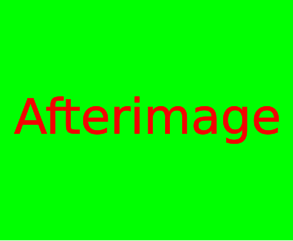 |
An afterimage or ghost image is an optical illusion that refers to an image continuing to appear in one’s vision after the exposure to the original image has ceased. Afterimages occur because photochemical activity in the retina continues even when the subject is no longer experiencing the original stimulus. An afterimage may be a normal phenomenon (physiological afterimage) or may be pathological (palinopsia). Illusory palinopsia may be a pathological exaggeration of physiological afterimages.
If the viewer stares at this image for 5 to 60 seconds and then looks at a white object, a negative afterimage will appear (in this case cyan on magenta). This can also be achieved by the viewer closing one’s eyes and tilting one’s head up. |
Afterimage on Empty Shape |
Afterimage on empty shape (also known as colour dove illusion) is designed to exploit graphical similarities. The effect is related to a class of effects referred to as contrast effects. In this effect, an empty (white) shape is presented on a coloured background for several seconds. When the background colour disappears (becomes white), an illusionary colour similar to the original background is perceived within the shape. |
Ambiguous Image |
These are images that can form two separate pictures. For example, the image shown forms a rabbit and a duck. Ambiguous images or reversible figures are optical illusion images which exploit graphical similarities and other properties of visual system interpretation between two or more distinct image forms. These are famous for inducing the phenomenon of multistable perception, the occurrence of an image being able to provide multiple, although stable, perceptions.
|
Ames Room Illusion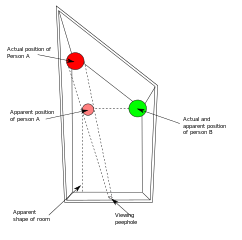 |
An Ames room is a distorted room used to create an optical illusion, such that a person standing in one corner appears to the observer to be a giant, while a person standing in the other corner appears to be a dwarf. The illusion is so convincing that a person walking back and forth from the left corner to the right corner appears to grow or shrink.
An Ames room is viewed with one eye through a peephole. The room appears to be an ordinary rectangular cuboid, with a back wall that is vertical and at right angles to an observer’s line of sight, two vertical side walls parallel to each other, and a horizontal floor and ceiling. The true shape of the room is that of a six-sided convex polyhedron: depending on the design of the room, all surfaces can be regular or irregular quadrilaterals so that one corner of the room is farther from an observer than the other. The geometry of the room is carefully designed, using perspective, so that, from the peephole, the image projected onto the retina of the observer’s eye is the same as that of an ordinary room. Once the observer is prevented from perceiving the real locations of the parts of the room, the illusion that it is an ordinary room occurs. One key aspect of preventing the observer from perceiving the true shape of the room is the peephole. It has at least three consequences:
|
Ames Trapezoid Window Illusion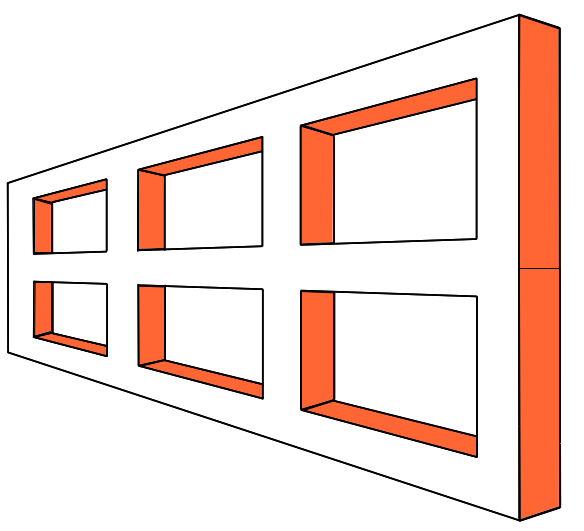 |
A window is formed in the shape of a trapezium. When observed, it appears to the human eye as a rectangular window, but is in fact a trapezoid. It is often hung and spun around to provide the illusion that the window rotates through less than 180 degrees.
When the rotation of the window is observed, the window appears to rotate through less than 180 degrees, though the exact amount of travel that is perceived varies with the dimensions of the trapezoid. It seems that the rotation stops momentarily and reverses its direction. It is therefore not perceived to be rotating continuously in one direction but instead is misperceived to be oscillating. During the 1960s, the concept of “transactional ambiguity” was studied and promulgated by some psychologists based on the use of the Ames Window. This hypothesis held that a viewer’s mental expectation or “set” could affect the actual perception of ambiguous stimuli, extending the long-held belief that mental set could affect one’s feelings and conclusions about stimuli to the actual visual perception of the stimuli itself. Although literature describing “transactional ambiguity” and the hypothesis of the perceptual effect of mental set has largely disappeared from the scene, it remains an interesting and provocative use of the visually ambiguous demonstrations for which Ames was well known, and if true provides additional scientific foundation for the “eye witness” phenomenon well known in law enforcement and research circles.
|
| Autokinetic Effect |
The autokinetic effect or autokinesis is a phenomenon of visual perception in which a stationary, small point of light in an otherwise dark or featureless environment appears to move. It was first recorded by a Russian officer keeping watch, who observed illusory movement of a star near the horizon. It is presumed to occur because motion perception is always relative to some reference point, and in darkness or in a featureless environment there is no reference point, so the position of the single point is undefined. |
Autostereogram  |
An autostereogram is a single-image stereogram (SIS), designed to create the visual illusion of a three-dimensional (3D) scene from a two-dimensional image. In order to perceive 3D shapes in these autostereograms, one must overcome the normally automatic coordination between accommodation (focus) and horizontal vergence (angle of one’s eyes). The illusion is one of depth perception and involves stereopsis: depth perception arising from the different perspective each eye has of a three-dimensional scene, called binocular parallax. For example, the random-dot autostereogram features a raised shark with fine gradient on a flat background.
Autostereograms are similar to normal stereograms except they are viewed without a stereoscope. The simplest type of autostereogram consists of horizontally repeating patterns (often separate images) and is known as a wallpaper autostereogram. When viewed with proper convergence, the repeating patterns appear to float above or below the background. The well-known Magic Eye books feature another type of autostereogram called a random dot autostereogram. One such autostereogram is illustrated above right. In this type of autostereogram, every pixel in the image is computed from a pattern strip and a depth map. A hidden 3D scene emerges when the image is viewed with the correct convergence.
|
Barberpole Illusion 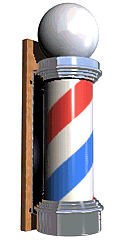 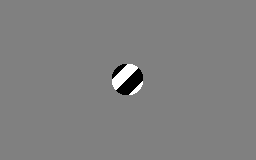 |
The barberpole illusion is a visual illusion that reveals biases in the processing of visual motion in the human brain. When a diagonally striped pole is rotated around its vertical axis (horizontally), it appears as though the stripes are moving downwards in the direction of its vertical axis rather than around it. This illusion occurs because a bar or contour within a frame of reference provides ambiguous information about its “real” direction of movement. The actual motion of the line has many possibilities. The shape of the aperture thus tends to determine the perceived direction of motion for an otherwise identically moving contour. A vertically elongated aperture makes vertical motion dominant whereas a horizontally elongated aperture makes horizontal motion dominant. In the case of a circular or square aperture, the perceived direction of movement is usually orthogonal to the orientation of the stripes (diagonal, in this case). The perceived direction of movement relates to the termination of the line’s end points within the inside border of the occluder. The vertical aperture, for instance, has longer edges at the vertical orientation, creating a larger number of terminators unambiguously moving vertically. This stronger motion signal forces us to perceive vertical motion. Functionally, this mechanism has evolved to ensure that we perceive a moving pattern as a rigid surface moving in one direction.
Individual motion-sensitive neurons in the visual system have only limited information, as they see only a small portion of the visual field (a situation referred to as the “aperture problem”). In the absence of additional information the visual system prefers the slowest possible motion: i.e., motion orthogonal to the moving line. Neurons have been identified in the visual cortex of ferrets, the activity of which may correspond to the perception of patterns such as barber poles. |
Benham’s Top |
Named after the English newspaper-man and toymaker Charles Benham, who in 1895 sold a top painted with the pattern shown. When the disk is spun, arcs of pale colour called Fechner colours or pattern-induced flicker colours (PIFCs) are visible at different places on the disk.
The phenomenon is not entirely understood. One possible reason people see colours may be that the colour receptors in the human eye respond at different rates to red, green, and blue. More specifically, the latencies of the centre and the surrounding mechanisms differ for the different types of colour-specific ganglion cells. The phenomenon originates from neural activity in the retina and spatial interactions in the primary visual cortex, which plays a role in encoding low-level image features, such as edges and spatiotemporal frequency components. Research indicates that the blue-yellow opponent process accounts for all the different PIFCs. Benham’s top and other PIFCs are being researched for use as a diagnostic tool for diseases of the eye and the visual track. It has shown particular promise in detecting optic neuritis. |
Beta Movement  |
An optical illusion, first described by Max Wertheimer in 1912, whereby a series of static images on a screen creates the illusion of a smoothly flowing scene. This occurs when the frame rate is greater than 10 to 12 separate images per second. It might be considered similar to the effects of animation. The illusion of motion caused by animation is thought to rely on beta movement and the phi phenomenon, but the exact causes are still unclear. The static images do not physically change but give the appearance of motion because of being rapidly changed faster than the eye can see.
This optical illusion is caused by the fact that the human optic nerve responds to changes in light at about 10 cycles per second, so changes about double of this are registered as motion instead of being separate distinct images. One example of the beta movement effect would be a set of LEDs, as shown at the adjacent picture. The LEDs, electronically, are individually controlled, but our eyes and brains perceive them as a snake running clockwise around the four edges of the square picture. This is also seen commonly on LED displays. The beta phenomenon is often confused with the phi phenomenon but they are quite different physiologically. The phi phenomenon can be considered to be an apparent movement caused by luminous impulses in sequence, (that is to say, it is lights going on and off at regular intervals), whereas the beta movement is an apparent movement caused by lights that do not move, but seem to. |
| Bezold Effect |
 When small areas of colour are interspersed, an apparent change of tone of a colour due to the alteration of the colour of the background. A colour may appear different depending on its relation to adjacent colours. In the example, the red seems lighter combined with the white, and darker combined with the black. The Bezold effect is an optical illusion, named after a German professor of meteorology, Wilhelm von Bezold (1837–1907), who discovered that a color may appear different depending on its relation to adjacent colors. It happens when small areas of colour are interspersed. An assimilation effect called the von Bezold spreading effect, similar to spatial colour mixing, is achieved. The opposite effect is observed when large areas of colour are placed adjacent to each other, resulting in colour contrast. |
Café Wall Illusion  |
This geometrical-optical illusion is a pattern where different coloured squares on a wall appear to form horizontal curved lines. It is named such because this is the type of artwork often seen on café walls.
It was first described under the name Kindergarten illusion in 1898, and rediscovered in 1973 by Richard Gregory. According to Gregory, this effect was observed by a member of his laboratory, Steve Simpson, in the tiles of the wall of a café at the bottom of St Michael’s Hill, Bristol It is a variant of the shifted-chessboard illusion originated by Hugo Münsterberg. In the construction of the optical illusion often each “brick” is surrounded by a layer of “mortar” intermediate between the dark and light colours of the “bricks”. In the first attempt at its deconstruction, the illusion was ascribed largely to irradiation, the light spread from dark to bright zones in the retinal image, and the image disappears when black and white are replaced by different colours of the same brightness. But a component of the illusion remains even when all optical and retinal components are factored out. Contrast polarities seem to be the determining factor in the tilt’s direction.
|
Catoptric Cistula |
A box with insides made of mirrors so as to distort, magnify or multiply images of objects put into the box. Also called a catoptric theatre or chest. The most elaborate catoptric chests known from Ancient Rome exhibited detailed scenes, including expansive libraries, forests, cities or even vast treasures. Another form of entertainment involved placing an animal, such as a cat, inside a chest, and watching it interact with numerous other cats that appeared to surround it. The torture chamber in the Phantom of the Opera is a six-sided catoptric chamber. The TARDIS of the television series Doctor Who is perhaps a modern expression, though fictional, of the effect sought to be created in the mind of the viewer of a catoptric chamber. |
Checker Shadow Illusion  |
Published by Edward H Adelson, Professor of Vision Science at MIT in 1995, the checker shadow illusion shows that when a shadow is cast onto a checked board, the colours of squares A and B in the photos appear to be different, when in fact they are the same. This can be proven using the following methods:
|
Chubb Illusion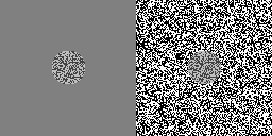 |
The Chubb illusion is an optical illusion or error in visual perception in which the apparent contrast of an object varies substantially to most viewers depending on its relative contrast to the field on which it is displayed. The central circular areas of two rectangular fields are identical, but appear different because the background fields are different. An object of low-contrast visual texture surrounded by a field of uniform visual texture appears to have higher contrast than when presented on a field of high-contrast texture. |
Colour Constancy  |
Colour constancy is an example of subjective constancy and a feature of the human colour perception system which ensures that the perceived colour of objects remains relatively constant under varying illumination conditions. A green apple for instance looks green to us at midday, when the main illumination is white sunlight, and also at sunset, when the main illumination is red. The colours of a hot air balloon are recognized as being the same in sun and shade.
In these two pictures, the second card from the left seems to be a stronger shade of pink in the upper one than in the lower one. In fact they are the same colour (since they have the same RGB values), but perception is affected by the colour cast of the surrounding photo. The phenomenon of colour constancy occurs when the source of illumination is not directly known. It is for this reason that colour constancy takes a greater effect on days with sun and clear sky as opposed to days that are overcast. Even when the sun is visible, colour constancy may affect colour perception. This is due to an ignorance of all possible sources of illumination. Although an object may reflect multiple sources of light into the eye, colour constancy causes objective identities to remain constant. D H Foster (2011) states, “in the natural environment, the source itself may not be well defined in that the illumination at a particular point in a scene is usually a complex mixture of direct and indirect [light] distributed over a range of incident angles, in turn modified by local occlusion and mutual reflection, all of which may vary with time and position.” The wide spectrum of possible illuminances in the natural environment and the limited ability of the human eye to perceive colour means that colour constancy plays a functional role in daily perception. Colour constancy allows for humans to interact with the world in a consistent or veridical manner and it allows for one to more effectively make judgements on the time of day. |
Colour Phi Phenomenon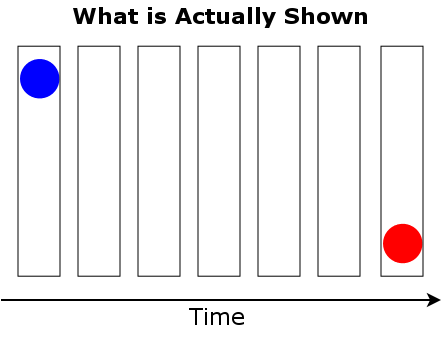  |
The colour phi phenomenon is a perceptual illusion in which a disembodied perception of motion is produced by a succession of still images. What is actually shown: First a blue dot is shown at the top of the screen, followed by a period of blank screen. Finally a red dot is shown at the bottom of the screen. Subjects report seeing a dot that moves from the top to the bottom. The dot changes color midway through its path. |
| Contingent Aftereffect | An illusory percept that is apparent on a test stimulus after exposure to an induction stimulus for an extended period. Contingent aftereffects can be contrasted with simple aftereffects, the latter requiring no test stimulus for the illusion/mis-perception to be apparent. Contingent aftereffects have been studied in different perceptual domains. For instance, visual contingent aftereffects, auditory contingent aftereffects and haptic contingent aftereffects have all been discovered.
An example of a visual contingent aftereffect is the McCollough effect. There are also colour-contingent motion aftereffects, and other varieties of these phenomena. |
| Convergence Micropsia | A type of micropsia characterized by the reduction in apparent size of objects viewed when the eyes are more converged than they need to be for the distance of the object from the eyes. It occurs mainly during stereoscopy and when viewing autostereograms (such as Magic Eye pictures). In these cases, the object is depicted by the two half images of a stereogram or by the contents of the autostereogram. Moving the stereogram or the autostereogram closer to the eyes increases convergence of the eyes and reduces the apparent size of the depicted object. If a correctly arranged stereogram or autostereogram is viewed with crossed eyes, then the depicted objects will appear smaller than if it is viewed with eyes diverged or parallel.
Convergence micropsia could also occur if one looked at the world through base-out prisms. |
Cornsweet Illusion  |
An illusion where two colours can obviously be seen to be different when placed directly beside each other; however, when the two colours are separated by a thick black line, they appear to be of the same hue. In the image at right, the entire region to the right of the “edge” in the middle looks slightly lighter than the area to the left of the edge, but in fact the brightness of both areas is exactly the same, as can be seen by blacking out the region containing the edge.
This phenomenon is similar to the phenomenon of simultaneous contrast and Mach bands, but differs from it in two important respects.
|
Delboeuf Illusion |
The Delboeuf illusion is an optical illusion of relative size perception. The two black circles are exactly the same size; however, the one on the left seems larger. A 2005 study suggests that it is caused by the same visual processes that cause the Ebbinghaus illusion
The Delboeuf illusion was named for the Belgian Philosopher, Mathematician, Experimental Psychologist, Hypnotist and Psychophysicist, Joseph Remi Leopold Delboeuf (1831 – 1896), who created it in 1865. |
Disappearing Model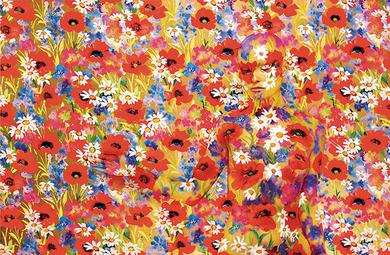 |
Disappearing model is a trompe-l’œil body painting by Joanne Gair to “make people disappear by painting them right into a background or paint clothing on a human body that is virtually undistinguishable from actual fabric!” It was part of episode 1.19 or 119 of Ripley’s Believe It or Not!, which was the highest rated episode. During the episode, Gair exhibits body painting that appears to be no-fabric clothing and creates another work that causes the illusion that a model disappears into the background of a flower print. This 2000 body painting is deemed to be Gair’s most famous work. |
Ebbinghaus illusion |
The Ebbinghaus illusion or Titchener circles is an optical illusion of relative size perception. The two orange circles are exactly the same size; however, the one on the right appears larger. As a result of the juxtaposition of circles, the central circle surrounded by large circles seems smaller than the central circle surrounded by small circles.
Recent work suggests that two other critical factors involved in the perception of the Ebbinghaus illusion are the distance of the surrounding circles from the central circle and the completeness of the annulus, which makes the illusion comparable in nature to the Delboeuf illusion. Regardless of relative size, if the surrounding circles are closer to the central circle, the central circle appears larger and if the surrounding circles are far away, the central circle appears smaller. While the distance variable appears to be an active factor in the perception of relative size, the size of the surrounding circles limits how close they can be to the central circle, resulting in many studies confounding the two variables. The Ebbinghaus illusion has been used to explain the moon illusion. |
Ehrenstein Illusion  |
The Ehrenstein illusion is an optical illusion studied by the German psychologist Walter Ehrenstein in which the sides of a square placed inside a pattern of concentric circles take an apparent curved shape.
Sometimes the name “Ehrenstein” is associated with one of the illusory contour figures. The ends of the dark segments produce the illusion of circles. The apparent figures have the same color as the background, but appear brighter. A similar effect is obtained in the Kanizsa triangle. |
Fechner Colour |
The Fechner colour effect is an illusion of colour seen when looking at certain rapidly changing or moving black-and-white patterns. They are also called pattern induced flicker colours (PIFCs). The effect is most commonly demonstrated with a device known as Benham’s top. It can also be seen in stroboscopic lights when flashes are set at certain critical speeds. Rotating fan blades, particularly aluminium ones, can also demonstrate the effect; as the fan accelerates or decelerates, the colours appear, drift, change and disappear. The phenomenon originates from neural activity in the retina and spatial interactions in the primary visual cortex, which processes pattern recognition. |
Figure-Ground Perception 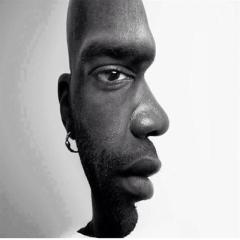 |
The faces–vase drawing that Danish psychologist Edgar Rubin described exemplifies one of the key aspects of figure–ground organization, edge-assignment and its effect on shape perception, which depends critically on the direction in which the border (edge) between the black and white regions is assigned. If the two curvy edges between the black and white regions are assigned inward then the central white region is seen as a vase shape in front of a black background. No faces are perceived in this case. On the other hand, if the edges are assigned outwards, then the two black profile faces are perceived on a white background and no vase shape is perceived. The human visual system will then settle on either of the interpretations of the Rubin vase and alternate between them. Functional brain imaging shows that when people see the Rubin image as a face, there is activity in the temporal lobe, specifically in the face-selective region.
This is an instance of multistability (or multistable perception), the tendency of ambiguous perceptual experiences to pop back and forth unstably between two or more alternative interpretations. |
Filling-In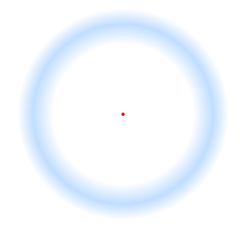 |
In vision, filling-in phenomena are those responsible for the completion of missing information across the physiological blind spot, and across natural and artificial scotomata. When steadily fixating the central dot for many seconds, the peripheral annulus will fade and will be replaced by the colour or texture of the background. When a textured stimulus is presented centred on but extending beyond the region of the blind spot, a continuous texture is perceived.
A second type of example relates to entirely stabilized stimuli. Their colour and lightness fade until they are no longer seen and the area fills in with the colour and lightness of the surrounding region. A famous example of fading under steady fixation is Troxler’s fading. |
Flash Lag Illusion |
The flash lag illusion or flash-lag effect is a visual illusion wherein a flash and a moving object that appear in the same location are perceived to be displaced from one another.
When a visual stimulus moves along a continuous trajectory, it may be seen ahead of its veridical position with respect to an unpredictable event such as a punctuate flash. This illusion tells us something important about the visual system: contrary to classical computers, neural activity travels at a relatively slow speed. It is largely accepted that the resulting delays cause this perceived spatial lag of the flash. Still, after several decades of debates, there is no consensus regarding the underlying mechanisms. A recent study tries to reconcile these different approaches by approaching perception as an inference mechanism aiming at describing what is happening at the present time. In particular, it could extend the motion extrapolation hypothesis by weighting this prediction by the precision of the current information. Thus, the corrected position of the moving target is calculated by combining the sensory flux with the internal representation of the trajectory, both of which exist in the form of probability distributions. To manipulate the trajectory is to change the precision and therefore the relative weight of these two information when they are optimally combined in order to know where an object is at the present time. For an object that moves predictably, the neural network can infer its most probable position taking into account this processing time. For the flash, however, this prediction can not be established because its appearance is unpredictable. Thus, while the two targets are aligned on the retina at the time of the flash, the position of the moving object is anticipated by the brain to compensate for the processing time: it is this differentiated treatment that causes the flash-lag effect. Moreover, this could also explain related phenomena such as motion reversal. |
Forced Perspective   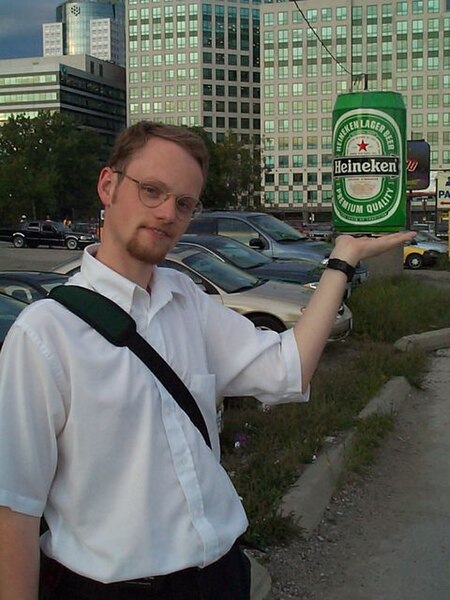 |
A technique involving optical illusion, used in photography, filmmaking and architecture to make an object appear farther away, closer, larger or smaller than it actually is, by manipulating human visual perception through the use of scaled objects and the correlation between them and the vantage point of the spectator or camera.
The Potemkin Stairs in Odessa extend for 142 metres (466 ft), but give the illusion of greater depth since the stairs are wider at the bottom than at the top. The forced perspective gallery at the Palazzo Spada in Rome by Francesco Borromini, 1632. The 8.6 metre (28 ft) long gallery gives the illusion of being around four times the length. One example of forced perspective is a scene in an action/adventure movie in which dinosaurs are threatening the heroes. By placing a miniature model of a dinosaur close to the camera, the dinosaur may be made to look monstrously tall to the viewer, even though it is just closer to the camera. Forced perspective had been a feature of German silent films and Citizen Kane revived the practice. Movies, especially B-movies in the 1950s and 1960s, were produced on limited budgets and often featured forced perspective shots. Peter Jackson‘s film adaptations of The Lord of the Rings make extended use of forced perspective. Characters apparently standing next to each other would be displaced by several feet in depth from the camera. This, in a still shot, makes some characters appear much smaller (for the dwarves and Hobbits) in relation to others. Portions of sets were mounted on movable platforms which would move precisely according to the movement of the camera, so that the optical illusion would be preserved at all times for the duration of the shot. The same techniques were used in the Harry Potter movies to make the character Hagrid look like a giant. Props around Harry and his friends are of normal size, while seemingly identical props placed around Hagrid are in fact smaller. As with many film genres and effects, forced perspective can be used to visual-comedy effect. Typically, when an object or character is portrayed in a scene, its size is defined by its surroundings. A character then interacts with the object or character, in the process showing that the viewer has been fooled and there is forced perspective in use. Use of forced perspective with the Leaning Tower of Pisa is popular in tourist photography. Another example is a giant beer can model shown “perched” on top of a person’s hand.
|
Fraser Spiral Illusion |
The Fraser spiral illusion, or false spiral, or the twisted cord illusion, was first described by the British psychologist Sir James Fraser in 1908. The overlapping black arc segments appear to form a spiral; however, the arcs are a series of concentric circles. The visual distortion is produced by combining a regular line pattern (the circles) with misaligned parts (the differently colored strands). Zöllner’s illusion and the café wall illusion are based on a similar principle, like many other visual effects, in which a sequence of tilted elements causes the eye to perceive phantom twists and deviations. |
Gravity Hill |
A gravity hill, also known as a magnetic hill, mystery hill, mystery spot, gravity road or anti-gravity hill, is a place where the layout of the surrounding land produces an optical illusion, making a slight downhill slope appear to be an uphill slope. Thus, a car left out of gear will appear to be rolling uphill against gravity. There are hundreds of recognised gravity hills around the world.
The slope of gravity hills is an optical illusion, although sites are often accompanied by claims that magnetic or supernatural forces are at work. The most important factor contributing to the illusion is a completely or mostly obstructed horizon. Without a horizon, it becomes difficult to judge the slope of a surface, as a reliable reference is missing. Objects one would normally assume to be more or less perpendicular to the ground (such as trees) may actually be leaning, offsetting the visual reference. The illusion is similar to the Ames room, in which objects can also appear to roll against gravity. A similar phenomenon — an uphill road that appears flat — is known in bicycle racing as a “false flat“.
|
Grid Illusion 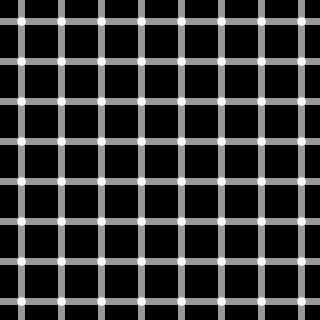 |
A grid illusion is any kind of grid that deceives a person’s vision. The two most common types of grid illusions are the Hermann grid illusion (1870) and the scintillating grid illusion (1994).
The first is characterized by “ghostlike” grey blobs perceived at the intersections of a white (or light-colored) grid on a black background. The grey blobs disappear when looking directly at an intersection. The second is constructed by superimposing white discs on the intersections of orthogonal grey bars on a black background. Dark dots seem to appear and disappear rapidly at random intersections, hence the label “scintillating”. When a person keeps his or her eyes directly on a single intersection, the dark dot does not appear. The dark dots disappear if one is too close to or too far from the image. The difference between the Hermann grid illusion and the scintillating illusion is that scintillating illusions have dots already in place at the intersection, whereas there are no dots already in place at the intersections of Hermann grid illusions. Since they are so similar, the two names are commonly used interchangeably. But the scintillating illusion does not occur with an isolated intersection, as in the case of the Hermann grid; observations suggest that a minimum of 3 × 3 evenly spaced intersections with superimposed discs are required to produce the effect. This requirement suggests the participation of global processes of the kind proposed for the linking and grouping of features in an image, in addition to local processes. The effect of both optical illusions is often explained by a neural process called lateral inhibition. The intensity at a point in the visual system is not simply the result of a single receptor, but the result of a group of receptors which respond to the presentation of stimuli in what is called a receptive field. |
Hering Illusion |
The Hering illusion is one of the geometrical-optical illusions and was discovered by the German physiologist Ewald Hering in 1861. When two straight and parallel lines are presented in front of radial background (like the spokes of a bicycle), the lines appear as if they were bowed outwards. The Orbison illusion is one of its variants, while the Wundt illusion produces a similar, but inverted effect.
There are several possible explanations for why perceptual distortion produced by the radiating pattern. The illusion was ascribed by Hering to an overestimation of the angle made at the points of intersection. If true, then the straightness of the parallel lines yields to that of the radiating lines, implying that there is a hierarchical ordering among components of such illusion. Others have suggested that angle overestimation results from lateral inhibition in visual cortex, while others have postulated a bias inherent in extrapolating 3D angle information from 2D projections. A different framework suggests that the Hering illusion (and several other geometric illusions) are caused by temporal delays with which the visual system must cope. In this framework, the visual system extrapolates current information to “perceive the present”: instead of providing a conscious image of how the world was ~100 ms in the past (when signals first struck the retina), the visual system estimates how the world is likely to look in the next moment. In the case of the Hering illusion, the radial lines trick the visual system into thinking it is moving forward. Since we are not actually moving and the figure is static, we misperceive the straight lines as curved — as they would appear in the next moment. |
Hollow-Face Illusion |
The hollow-face illusion is an optical illusion in which the perception of a concave mask of a face appears as a normal convex face.
While a convex face will appear to look in a single direction, and the gaze of a flat face, such as the Lord Kitchener Wants You poster, can appear to track a moving viewer, a hollow face can appear to move its eyes faster than the viewer: looking forward when the viewer is directly ahead, but looking at an extreme angle when the viewer is only at a moderate angle. According to Richard Gregory, “The strong visual bias of favouring seeing a hollow mask as a normal convex face is evidence for the power of top-down knowledge for vision”. This bias of seeing faces as convex is so strong that it counters competing monocular depth cues such as shading and shadows, and also very considerable unambiguous information from the two eyes signalling stereoscopically that the object is hollow. (Lighting a concave face from below to reverse the shading cues making them closer to those of a convex face lit from above can reinforce the illusion.) The Hollow-Face illusion is weaker among people with schizophrenia and other populations with psychotic symptoms, perhaps as a result of reduced tendency to interpret any kind of ambiguous 3D object as convex. It appears to be related to current mental state, namely in regard to current positive symptoms, inappropriate affect, and need for structure. The illusion seems to strengthen among successfully treated patients.
|
Hybrid Image |
A Hybrid image is an optical illusion developed at MIT in which an image can be interpreted in one of two different ways depending on viewing distance. Looking at the picture from a short distance, one can see a sharp image of Einstein, with only a hint of blurry distortion hinting at the presence of an overlaid image. Viewed from a distance in which the fine detail blurs, the unmistakable face of Monroe emerges.
Another example shows a textual hybrid image reading “southeast” up close and “northwest” from afar. The technique for creating hybrid images exhibiting this optical illusion was developed by Aude Oliva of MIT and Philippe G Schyns of University of Glasgow, a method originally proposed by Schyns and Oliva in 1994. Hybrid images combine the low spatial frequencies of one picture with the high spatial frequencies of another picture, producing an image with an interpretation that changes with viewing distance. |
Illusory Contours   |
Illusory contours or subjective contours are visual illusions that evoke the perception of an edge without a luminance or colour change across that edge. These are instances of reification, the constructive or generative aspect of perception, by which the experienced percept contains more explicit spatial information than the sensory stimulus on which it is based. Objects in the natural world are often only partially visible. Illusory contours provide clues for how the visual system constructs surfaces when portions of the surface’s edge are not visible.
Kanizsa Figures (a.k.a. Pac-Man Configurations): Perhaps the most famous example of an illusory contour is the Pac-Man configuration popularized by Gaetano Kanizsa. Kanizsa figurers trigger the percept of an illusory contour by aligning Pac-Man-shaped inducers in the visual field such that the edges form a shape. Though not explicitly part of the image, Kanizsa figures evoke the percept of a shape, defined by a sharp illusory contour. Typically, the shape seems brighter than the background though luminance is in reality homogeneous. Additionally, the illusory shape seem to be closer to the viewer than the inducers. Kanizsa figures involve modal completion of the illusory shape and amodal completion of the inducers. Closely related to Kanizsa figures is the Ehrenstein illusion. Instead of employing Pac-Man inducers, the Ehrenstein illusion triggers an illusory contour percept via radial line segments. Ehrenstein’s discovery was originally contextualized as a modification of the Hermann grid. Neon color spreading is an optical illusion in the category of transparency effects, characterized by fluid borders between the edges of a coloured object and the background in the presence of black lines. |
Illusory Motion |
An optical illusion in which a static image appears to be moving due to the cognitive effects of interacting colour contrasts and shape position. Apparent motion (or beta movement) is the most common type of illusory motion, and is perceived when images are displayed in succession at a specific frame rate such as in a movie. Other types include induced movement, motion aftereffect, Stroboscopic effect and optical art. |
Impossible Object 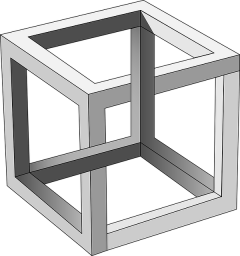 |
A type of optical illusion consisting of a two-dimensional figure which is instantly and subconsciously interpreted by the visual system as representing a projection of a three-dimensional object. A cube whose edges cross in an inconsistent way is an example of an impossible object, specifically an impossible cube (cf. Penrose triangle).
In most cases the impossibility becomes apparent after viewing the figure for a few seconds. However, the initial impression of a 3D object remains even after it has been contradicted. There are also more subtle examples of impossible objects where the impossibility does not become apparent spontaneously and it is necessary to consciously examine the geometry of the implied object to determine that it is impossible. The unsettling nature of impossible objects occurs because of our natural desire to interpret 2D drawings as three-dimensional objects. This is why a drawing of a Necker cube would be most likely seen as a cube, rather than “two squares connected with diagonal lines, a square surrounded by irregular planar figures, or any other planar figure.” With an impossible object, looking at different parts of the object makes one reassess the 3D nature of the object, which confuses the mind. |
Impossible Trident |
An impossible trident, also known as an impossible fork, a blivet, poiuyt or devil’s tuning fork, is an impossible image because in reality the shape cannot exist. It is a drawing of an impossible object (undecipherable figure), a kind of optical illusion. It appears to have three cylindrical prongs at one end, which then mysteriously transform into two rectangular prongs at the other end.
D H Schuster reported in 1964 that he noticed an ambiguous figure of a new kind in the advertising section of an aviation journal. He dubbed it a “three-stick clevis“. He described the novelty as follows: “Unlike other ambiguous drawings, an actual shift in visual fixation is involved in its perception and resolution.” |
Irradiation Illusion |
An illusion of visual perception in which a light area of the visual field looks larger than an otherwise identical dark area. It arises partly from scattering of light inside the eye. This has the effect of enlarging the image of a light area on the retina. It was named by Hermann von Helmholtz around 1867; but the illusion was familiar to scientists long before then; Galileo mentions it in his Dialogue Concerning the Two Chief World Systems. It arises partly from scattering of light inside the eye. This has the effect of enlarging the image of a light area on the retina. |
Isometric Illusion |
An isometric illusion (also called an ambiguous figure or inside/outside illusion) is a type of optical illusion, specifically one due to multistable perception, a form of perceptual phenomena in which there are unpredictable sequences of spontaneous subjective changes. While usually associated with visual perception (a form of optical illusion), such phenomena can also be found for auditory and olfactory precepts. |
Jastrow Illusion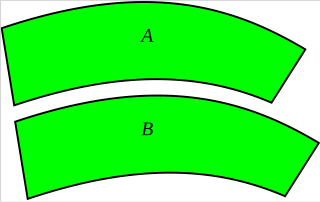 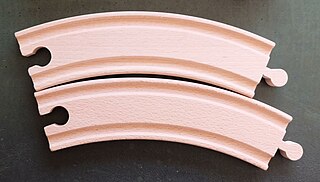 |
An optical illusion discovered by the American psychologist Joseph Jastrow in 1889. It is also called the ring-segment illusion, Wundt area illusion or Wundt-Jastrow illusion. In the illustration shown, the two toy railway tracks are identical, although the lower one appears to be larger. This illusion is often included in magic kits and several versions are sold in magic shops and is commonly known under the name Boomerang Illusion.
There are several competing explanations of why the brain perceives the difference in size between the ring segments, none of which has been accepted as definitive. One explanation relates to how the mind interprets the two-dimensional images on the retina as a three-dimensional world. Another explanation relates to the fact that the mind can only attend to a small field of vision, which is reconstructed by our consciousness. The most commonly used explanation is that the brain is confused by the difference in size between the large and the small radius. The short side makes the long side appear longer, and the long side makes the short side appear even shorter. |
Kanizsa Triangle |
The Kanizsa triangle is an optical illusion first described by the Italian psychologist Gaetano Kanizsa in 1955. It is a triangle formed of illusory contours (also called subjective contours), which are visual illusions that evoke the perception of an edge without a luminance or colour change across that edge. The spatially separate fragments give the impression of a bright triangle defined by a sharp illusory contour, occluding three black circles and a black-outlined triangle. These are instances of reification, the constructive or generative aspect of perception, by which the experienced percept contains more explicit spatial information than the sensory stimulus on which it is based. |
Kinetic Depth Effect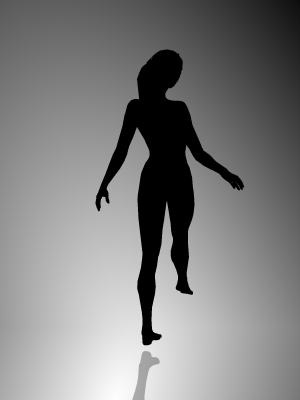 |
The Kinetic depth effect refers to the phenomenon whereby the three-dimensional structural form of a silhouette can be perceived when the object is moving. In the absence of other visual depth cues, this might be the only perception mechanism available to infer the object’s shape. Additionally the direction of motion can reverse due to the existence of multiple 3D visual solutions.
The Spinning Dancer is a kinetic, bistable optical illusion resembling a pirouetting female dancer. The dancer can be seen to be spinning alternately one direction, or the other. |
Leaning Tower Illusion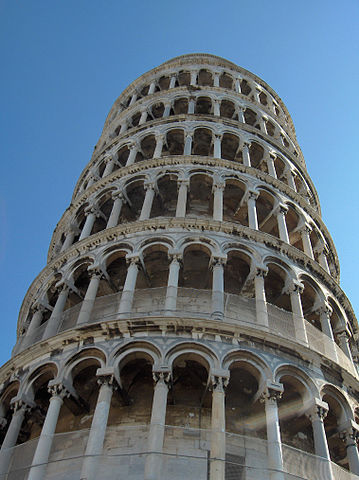  |
The Leaning tower illusion is an optical illusion that presents two identical images of the Leaning Tower of Pisa side by side. Although the images are duplicates, one has the impression that the tower on the right leans more, as if photographed from a different angle. The illusion occurs because of the way the visual system takes into account perspective. When two identical towers rise in parallel but are viewed from below, their corresponding outlines converge in the retinal image due to perspective. The visual system normally “corrects” for the perspective distortion and as a result perceives the towers correctly as rising in parallel. However in the case of the two identical images of the Pisa tower, the corresponding outlines of the towers do not converge but run in parallel, and as a result the towers are perceived as non-parallel or diverging. The illusion reveals that the visual system is obliged to treat the two images as part of the same scene, in other words as the “Twin Towers of Pisa”. |
Lilac Chaser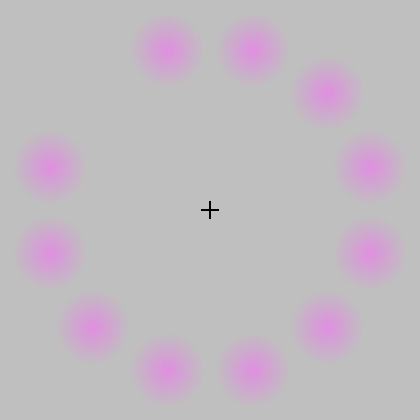 |
Lilac chaser is a visual illusion, also known as the Pac-Man illusion. It consists of 12 lilac (or pink, rose, or magenta), blurred discs arranged in a circle (like the numbers on a clock), around a small black, central cross on a grey background. One of the discs disappears briefly (for about 0.1 seconds), then the next (about 0.125 seconds later), and the next and so on, in a clockwise direction. When one stares at the cross for about 5 seconds or so, one sees three different things:
|
Liquid Crystal Shutter Glasses 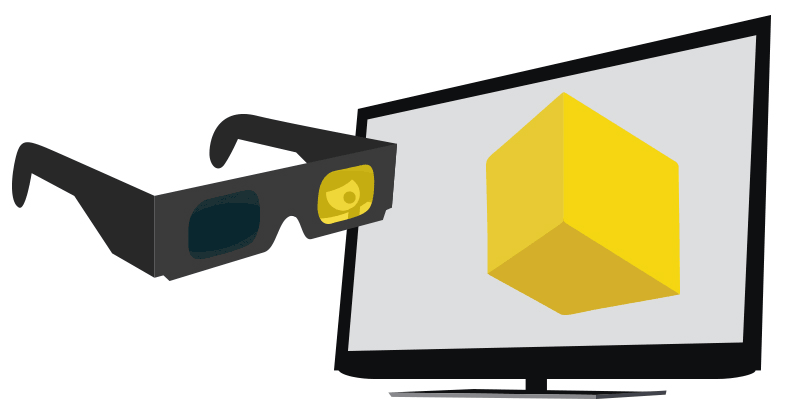   |
An active shutter 3D system (also called alternate frame sequencing, alternate image, AI, alternating field, field sequential or eclipse method) is a technique of displaying stereoscopic 3D images by only presenting the image intended for the left eye while blocking the right eye’s view, then presenting the right-eye image while blocking the left eye, and repeating this so rapidly that the interruptions do not interfere with the perceived fusion of the two images into a single 3D image.
Modern active shutter 3D systems generally use liquid crystal shutter glasses (also called “LC shutter glasses” or “active shutter glasses”). Each eye’s glass contains a liquid crystal layer which has the property of becoming opaque when voltage is applied, being otherwise transparent. The glasses are controlled by a timing signal that allows the glasses to alternately block one eye, and then the other, in synchronization with the refresh rate of the screen. The timing synchronization to the video equipment may be achieved via a wired signal, or wirelessly by either an infrared or radio frequency (e.g. Bluetooth, DLP link) transmitter. Historic systems also used spinning discs, for example the Teleview system. Active shutter 3D systems are used to present 3D films in some theatres, and they can be used to present 3D images on CRT, plasma, LCD, projectors and other types of video displays. |
Lunar Terminator Illusion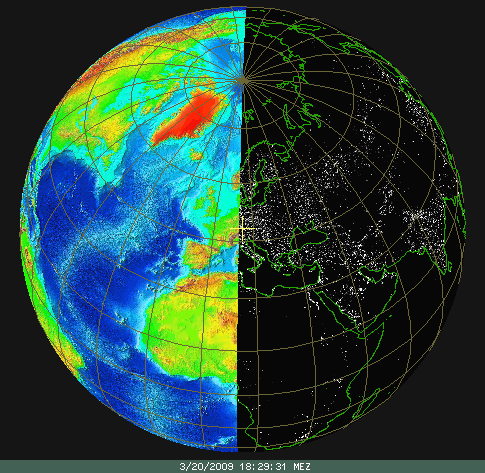 |
Lunar terminator illusion is an optical illusion where the apparent source of sunlight illuminating the moon does not corresponding with the actual position of the sun. It is an optical illusion arising from the erroneous expectation of an observer on Earth that the direction of sunlight illuminating the Moon (i.e. a line perpendicular to the terminator) should correspond with the position of the Sun, but does not appear to do so. The cause of the illusion is simply the observer not taking into account that the observed slope of a light ray will change across the sky because of the lack of visual clues to establish 3D perspective. |
Mach Bands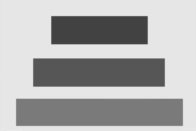  |
Named after the physicist Ernst Mach, Mach bands is an optical illusion that exaggerates the contrast between edges of the slightly differing shades of gray, as soon as they contact one another, by triggering edge-detection in the human visual system. The Mach bands effect is due to the spatial high-boost filtering performed by the human visual system on the luminance channel of the image captured by the retina. The effect is independent of the orientation of the boundary. Mach reported the effect in 1865, conjecturing that filtering is performed in the retina itself, by lateral inhibition among its neurons. This conjecture is supported by observations on other (non-visual) senses, as pointed out by von Békésy. The visual pattern is often found on curved surfaces subject to a particular, naturally-occurring illumination, so the occurrence of filtering can be explained as the result of learnt image statistics. The effect of filtering can be modeled as a convolution between a trapezoidal function that describes the illumination and one or more bandpass filters. A tight approximation is obtained by a model employing 9 even-symmetric filters scaled at octave intervals.
This visual phenomenon is important to keep in mind when evaluating dental radiographs for evidence of decay, in which grayscale images of teeth and bone are analyzed for abnormal variances of intensity. A false-positive radiological diagnosis of dental caries can easily arise if the practitioner does not take into account the likelihood of this illusion. Mach bands manifest adjacent to metal restorations or appliances and the boundary between enamel and dentin. Mach bands may also result in the misdiagnosis of horizontal root fractures because of the differing radiographic intensities of tooth and bone. Mach effect can also lead to an erroneous diagnosis of pneumothorax by creating a dark line at the lung periphery (whereas a true pneumothorax will have a white pleural line).
|
McCollough Effect   |
The McCollough effect (1965) is a phenomenon of human visual perception in which colourless gratings appear coloured contingent on the orientation of the gratings. It is an aftereffect requiring a period of induction to produce it. For example, if someone alternately looks at a red horizontal grating and a green vertical grating for a few minutes, a black-and-white horizontal grating will then look greenish and a black-and-white vertical grating will then look pinkish. The effect is remarkable because it can last up to three months or more under certain circumstances.
The effect is different from coloured afterimages, which appear superimposed on whatever is seen and which are quite brief. It depends on retinal orientation (tilting the head to the side by 45 degrees makes the colors in the above example disappear; tilting the head by 90 degrees makes the colors reappear such that the gravitationally vertical grating now looks green). Multiple effects can be stacked by inducting with multiple sets of grids. A set of horizontal and vertical induction grids and a separate set of opposing diagonal induction grids will produce two distinct afterimages when a black and white grid is held normally, and at 45 degrees. The induction stimuli can have any different colours. The effect is strongest, however, when the colours are complementary, such as red and green, or blue and orange. The effect is also optimal when the thickness of the bars in the induction stimulus matches that of those in the test stimulus (i.e., the effect is tuned, albeit broadly, to spatial frequency). This property led to non-redundant effects being reported by people who had used computer monitors with uniformly coloured phosphors to do word processing. These monitors were popular in the 1980s, and commonly showed text as green on black. People noticed later when reading text of the same spatial frequency, such as in a book, that it looked pink. Also a horizontal grating of the same spatial frequency as the horizontal lines of the induction text (such as the horizontal stripes on the letters “IBM” on the envelope for early floppy disks) looked pink. A variety of similar aftereffects have been discovered not only between pattern and colour contingencies, but between movement/colour, spatial frequency/colour and other relationships. All such effects may be referred to as McCollough Effects or MEs. |
Missing Square Puzzle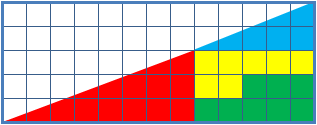    |
The missing square puzzle is an optical illusion used in mathematics classes for helping students to reason about geometrical figures; or rather to teach them not to reason using figures, but to use only textual descriptions and the axioms of geometry. It depicts two arrangements made of similar shapes in slightly different configurations. The key to the puzzle is the fact that neither of the 13×5 “triangles” is truly a triangle, because what appears to be the hypotenuse is bent. In other words, the “hypotenuse” does not maintain a consistent slope, even though it may appear that way to the human eye.
A true 13×5 triangle cannot be created from the given component parts. The four figures (the yellow, red, blue and green shapes) total 32 units of area. The apparent triangles formed from the figures are 13 units wide and 5 units tall, so it appears that the area should be S = 13 × 5 / 2 = 32.5 units. However, the blue triangle has a ratio of 5:2 (=2.5), while the red triangle has the ratio 8:3 (≈2.667), so the apparent combined hypotenuse in each figure is actually bent. Given the bent hypotenuse, the first figure actually occupies a combined 32 units, while the second figure occupies 33, including the “missing” square. Mitsunobu Matsuyama’s “Paradox” uses four congruent quadrilaterals and a small square, which form a larger square. The apparent paradox is explained by the fact that the side of the new large square is a little smaller than the original one. |
Moon Illusion    |
The Moon illusion is an optical illusion in which the Moon appears to be 50% to 75% larger near the horizon than it does while higher up in the sky. The same illusion applies to any sizeable object in the sky, such as the sun or a constellation.
In the diagram of the Moon seen against a cloud of the same size at different heights in the sky, when the Moon is high, the clouds against it are closer to the viewer and appear larger. When the Moon is low in the sky, the same clouds are further away and appear smaller, giving the illusion of a larger Moon. The Ebbinghaus illusion has been used to explain the phenomenon. The lower central circle surrounded by small circles might represent the horizon Moon accompanied by objects of smaller visual extent, while the upper central circle represents the zenith Moon surrounded by expanses of sky of larger visual extent. Although both central circles are actually the same size, the lower one looks larger to many people. The size of a viewed object can be measured objectively either as an angular size (the visual angle that it subtends at the eye, corresponding to the proportion of the visual field that it occupies), or as physical size (its real size measured in, say, meters). Perceived size is only loosely related to these concepts, however. For example, if two identical, familiar objects are placed at distances of five and ten meters, respectively, then the more distant object subtends approximately half the visual angle of the nearer object, but we normally perceive that as the same size (a phenomenon referred to as size constancy), not as half the size. Conversely, if the more distant object did subtend the same angle as the nearer object then we would normally perceive it to be twice as big. One question concerning the Moon illusion, therefore, is whether the horizon Moon appears larger because its perceived angular size seems greater, or because its perceived physical size seems greater, or some combination of both. There is currently no consensus on this point. Most recent research on the Moon illusion has been conducted by psychologists specializing in human perception. The 1989 book The Moon Illusion, edited by Hershenson, offers about 24 chapters written by various illusion researchers reaching different conclusions. After reviewing the many different explanations in their 2002 book The Mystery of the Moon Illusion, Ross and Plug conclude “No single theory has emerged victorious”. They argue that the size of the illusion is variable, but is usually an apparent increase in diameter of about 50 percent. The most important factor is the sight of the terrain, but there is a small contribution from other factors such as the angle of regard, posture and eye movements.
|
| Motion Aftereffect |
A visual illusion experienced after viewing a moving visual stimulus for a time (tens of milliseconds to minutes) with stationary eyes, and then fixating a stationary stimulus. The stationary stimulus appears to move in the opposite direction to the original (physically moving) stimulus. The motion aftereffect is believed to be the result of motion adaptation.
For example, if one looks at a waterfall for about a minute and then looks at the stationary rocks at the side of the waterfall, these rocks appear to be moving upwards slightly. The illusory upwards movement is the motion aftereffect. This particular motion aftereffect is also known as the waterfall illusion. Another example can be seen when one looks at the centre of a rotating spiral for several seconds. The spiral can exhibit outward or inward motion. When one then looks at any stationary pattern, it appears to be moving in the opposite direction. This form of the motion aftereffect is known as the spiral aftereffect. |
Motion Illusion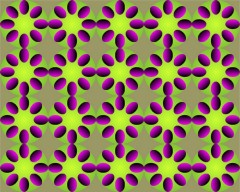 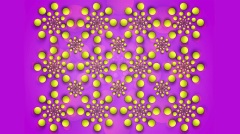 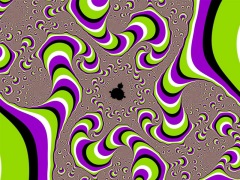 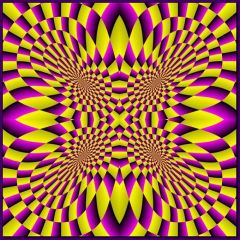   |
An optical illusion in which a static image appears to be moving due to the cognitive effects of interacting colour contrasts and shape position. Also known as illusory motion. Illusory motion is perceived as movement in a number of ways. The first can manifest through the retinal image where the motion flows across the retinal mosaic. The perceived motion can also manifest by the eyes changing position. In either case, an aftereffect may occur.
Induced movement works instead by moving the background around a fixed object. Films such as Airplane! and Top Secret! use a fixed prop and move the background props to give the effect of induced motion. Motion aftereffect occurs when one views moving stimuli for an extended period of time and then focus on a stationary object. The object will appear to move in the opposite direction of the moving stimuli. Illusory motion is perceived as movement in a number of ways. The first can manifest through the retinal image where the motion flows across the retinal mosaic. The perceived motion can also manifest by the eyes changing position. In either case, an aftereffect may occur. Theoretical example with the illusion of motion: It appears that the sky is falling, while the reality is that the ocean is rising. Illusory motion can occur in different circumstances.
Billboards and other electronic signs use apparent motion to simulate moving text by flashing lights on and off as if the text is moving. |
Müller-Lyer Illusion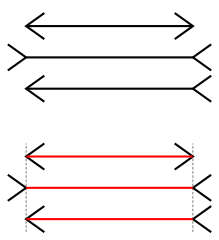 |
The Müller-Lyer illusion is an optical illusion consisting of a stylized arrow. When viewers are asked to place a mark on the figure at the midpoint, they invariably place it more towards the “tail” end.
A variation of the same effect (and the most common form in which it is seen today) consists of a set of arrow-like figures. Straight line segments of equal length comprise the “shafts” of the arrows, while shorter line segments (called the fins) protrude from the ends of the shaft. The fins can point inwards to form an arrow “head” or outwards to form an arrow “tail”. The line segment forming the shaft of the arrow with two tails is perceived to be longer than that forming the shaft of the arrow with two heads. |
Multistability    |
In a dynamical system, multistability is the property of having multiple stable equilibrium points in the vector space spanned by the states in the system. Multistable perceptual phenomena are a form of perceptual phenomena in which there are unpredictable sequences of spontaneous subjective changes.
Perceptual multistability can be evoked by visual patterns that are too ambiguous for the human visual system to recognise with one unique interpretation. Famous examples include the Necker cube, Schroeder staircase, structure from motion, monocular rivalry and binocular rivalry, but many more visually ambiguous images are known. Since most of these images lead to an alternation between two mutually exclusive perceptual states, they are sometimes also referred to as bistable perception. In vision science, multistable perception characterizes the wavering percepts that can be brought about by certain visually ambiguous pattern such as the Necker cube, monocular rivalry or binocular rivalry. Through lateral inhibition, a pattern in which one image, when stimulated, inhibit the activity of neighbouring images.
|
| Musion Eyeliner |
The Musion Eyeliner is a proprietary high definition video projection system that allows moving images to appear within a live stage setting. Thin metalized film is placed across the front of the stage at an angle of 45 degrees towards the audience; recessed below the screen is a bright image supplied by an LED screen or powerful projector. When viewed from the audience’s perspective, the reflected images appear to be on the stage.
Because the system uses a thin film as its reflective surface, the screen is relatively low-cost and light-weight, and can cover a large area without seams (thus helping maintain the illusion); however, this lightness can make the screen vibrate due to atmospheric effects such as wind, when outdoors; or powerful sound systems, when indoors. The system is intended to “create the illusion of life-size, full colour, 3D moving images”. It consists of a flat, two-dimensional image that produces the illusion of being three-dimensional and suspended in free space. It does not, for instance, recreate stereoscopy as most 3D displays do, nor is it a hologram. The system was first exhibited at an installation at the Swarovski Museum in Austria in 1995. Applications of the technology include teleconferencing and mixed-media entertainment and educational events. It was used at the Live Earth conference produced by Musion, as well as at the later concerts of the band Gorillaz, where it was used to allow the band’s cartoon musicians to join the actual musicians on stage. In 2014, a slightly different version was used for Michael Jackson’s performance at the 2014 Billboard Music Awards of the song, Slave to the Rhythm. Also in 2014, it earned a Guinness World record when it was used by Indian Politician Narendra Modi to give a speech at 53 places simultaneously. He was successful in his re-election that May. |
Necker Cube |
An optical illusion first published in 1832 by Swiss crystallographer Louis Albert Necker, comprising an ambiguous line drawing representing a cube, drawn with its edges as line segments. Since the cube can be interpreted as being in either of two different three-dimensional orientations, this illusion is an instance of multistability (or multistable perception), the tendency of ambiguous perceptual experiences to pop back and forth unstably between two or more alternative interpretations. |
Numerosity Adaptation Effect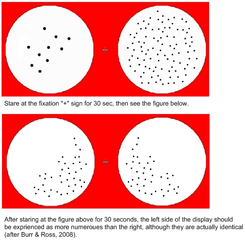 |
A perceptual phenomenon in numerical cognition which demonstrates non-symbolic numerical intuition and exemplifies how numerical percepts can impose themselves upon the human brain automatically. First reported in 2008, this effect is described only for controlled experimental conditions. In the illustration, a viewer should have a strong impression that the left display (lower figure) is more numerous than the right, after 30 seconds of viewing the adaptation (upper figure), although both have exactly the same number of dots. The viewer might also underestimate the number of dots presented in the display. Both aspects of the effect are resistant to manipulation of the non-numerical parameters of the display. Thus, this effect cannot be simply explained in terms of size, density or contrast.
Perhaps the most astonishing fact of these effects is that they happen immediately, and without conscious control. Knowing that the numbers are equal would not hamper their happening). |
Orbison Illusion |
First described by the psychologist William Orbison in 1939, the optical illusion comprises a two dimensional figure such as a circle or square superimposed over a background of radial lines or concentric circles. Both the figure and the rectangle containing it appear to be distorted; in particular, squares appear slightly bulged, circles appear elliptical, and the containing rectangle appears tilted. |
Pareidolia    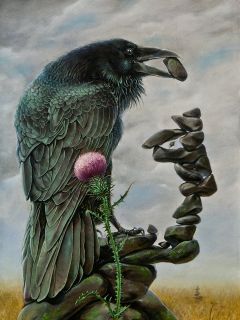 |
Pareidolia is an example of apophenia, the tendency to perceive connections and meaning between unrelated things. It is a psychological phenomenon in which the mind responds to a stimulus, usually an image or a sound, by perceiving a familiar pattern where none exists (e.g. in random data). Common examples are perceived images of animals, faces, or objects in cloud formations, the Man in the Moon and the Moon rabbit.
Pareidolia can cause people to interpret random images, or patterns of light and shadow, as faces. A 2009 magnetoencephalography study found that objects perceived as faces evoke an early (165 ms) activation of the fusiform face area at a time and location similar to that evoked by faces, whereas other common objects do not evoke such activation. This activation is similar to a slightly faster time (130 ms) that is seen for images of real faces. The authors suggest that face perception evoked by face-like objects is a relatively early process, and not a late cognitive reinterpretation phenomenon. A functional magnetic resonance imaging (fMRI) study in 2011 similarly showed that repeated presentation of novel visual shapes that were interpreted as meaningful led to decreased fMRI responses for real objects. These results indicate that the interpretation of ambiguous stimuli depends upon processes similar to those elicited by known objects. These studies help to explain why people identify a few circles and a line as a “face” so quickly and without hesitation. Cognitive processes are activated by the “face-like” object, which alert the observer to both the emotional state and identity of the subject, even before the conscious mind begins to process or even receive the information. A “stick figure face”, despite its simplicity, can convey mood information, and be drawn to indicate emotions such as happiness or anger. This robust and subtle capability is hypothesized to be the result of eons of natural selection favouring people most able to quickly identify the mental state, for example, of threatening people, thus providing the individual an opportunity to flee or attack pre-emptively. In other words, processing this information subcortically — therefore subconsciously — before it is passed on to the rest of the brain for detailed processing accelerates judgment and decision making when a fast reaction is needed. This ability, though highly specialized for the processing and recognition of human emotions, also functions to determine the demeanour of wildlife.
|
Penrose Stairs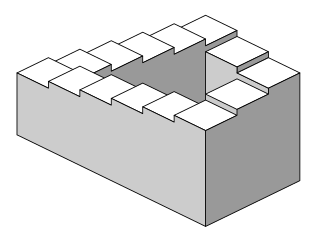 |
The Penrose stairs was created by Lionel Penrose and his son Roger Penrose. The “continuous staircase” was first presented in an article that the Penroses wrote in 1959, based on the so-called “triangle of Penrose” published by Roger Penrose in the British Journal of Psychology in 1958. A variation on the Penrose triangle, it is a two-dimensional depiction of a staircase in which the stairs make four 90-degree turns as they ascend or descend yet form a continuous loop, so that a person could climb them forever and never get any higher.
|
Penrose Triangle 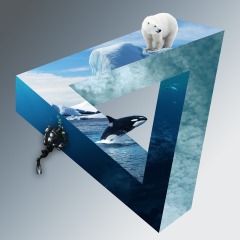 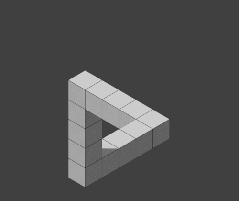 |
The Penrose triangle (also known as the Penrose tribar or impossible tribar) was first created by the Swedish artist Oscar Reutersvärd in 1934. The mathematician Roger Penrose independently devised and popularised it in the 1950s, describing it as “impossibility in its purest form”. A triangle whose edges cross in an inconsistent way is an example of an impossible object (cf. impossible cube).
The tribar appears to be a solid object, made of three straight beams of square cross-section which meet pairwise at right angles at the vertices of the triangle they form. The beams may be broken, forming cubes or cuboids. This combination of properties cannot be realized by any three-dimensional object in ordinary Euclidean space. Such an object can exist in certain Euclidean 3-manifolds. There also exist three-dimensional solid shapes each of which, when viewed from a certain angle, appears the same as the 2-dimensional depiction of the Penrose triangle on this page (such as – for example – the adjacent image depicting a sculpture in Perth, Australia). The term “Penrose triangle” can refer to the 2-dimensional depiction or the impossible object itself. Although the tribar is named one of the impossible objects, there exist many more that fit into the same category. Other impossible objects include the devil’s fork, the dancing elephant, and impossible arch. |
Pepper’s Ghost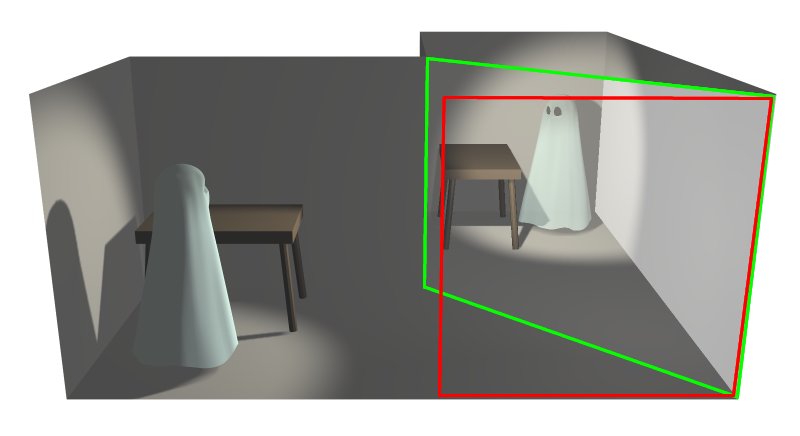 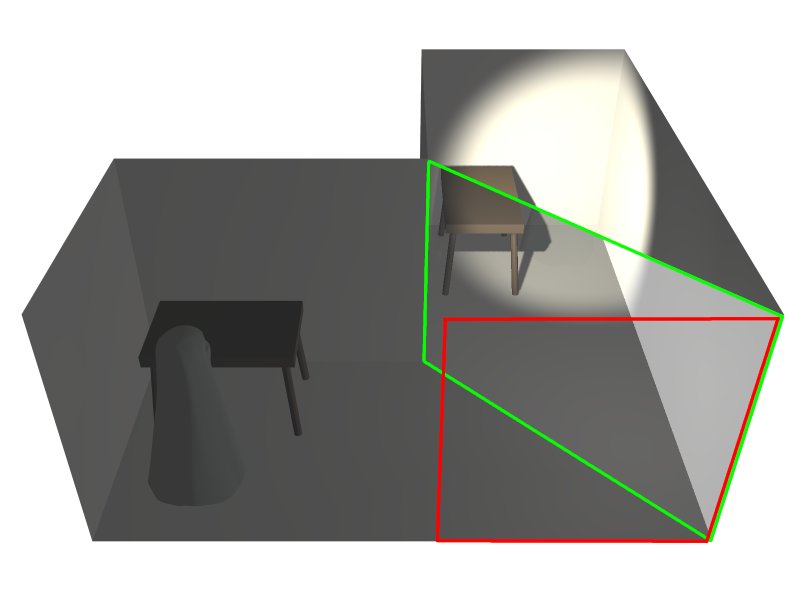  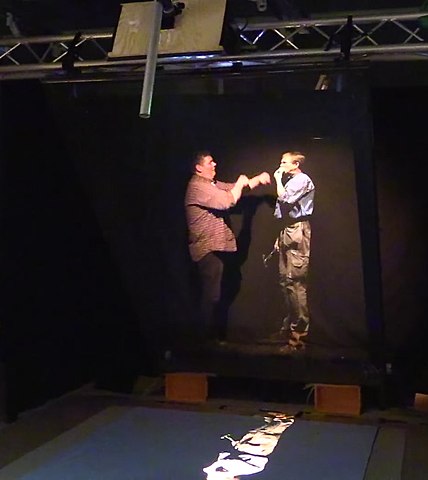  |
Pepper’s ghost is an illusion technique used in theatre, amusement parks, museums, television, and concerts. It is named after the English scientist John Henry Pepper (1821–1900) who popularized the effect in a demonstration in 1862.
An audience views a stage or room with various objects in it. On command, ghostly objects appear to fade in or out of existence in the room, or objects in the room magically transform into different objects. A viewer looking through the red rectangle sees a ghost floating next to the table. The illusion is produced by a large piece of glass, Plexiglas or plastic film situated at an angle between viewer and scene (green outline). The glass reflects a room hidden from the viewer (left), sometimes called a “blue room”, that is built as mirror-image of the scene. If the mirror-image room (left) is darkened, it does not reflect well in the glass. The empty room (top) is brightly lit, making it very visible to the viewer. When the lights in the mirror-image room are raised (with the empty room being dimmed slightly to compensate), the ghost appears out of nowhere. Projecting an image on the floor and reflecting it in a pane of glass allows a live actor (left) to interact with a projected “ghost”. Examples of the illusion are the Girl-to-Gorilla trick found in old carnival sideshows and the appearance of “Ghosts” at the Haunted Mansion and the “Blue Fairy” in Pinocchio’s Daring Journey at the Disneyland park in California. Teleprompters are a modern implementation of Pepper’s ghost used by the television industry. They reflect a speech or script and are commonly used for live broadcasts such as news programmes, formal events and concerts, such as the appearance of Tupac Shakur onstage with Dr Dre and Snoop Dogg at the 2012 Coachella Music and Arts Festival, and Michael Jackson at the 2014 Billboard Music Awards. The world’s largest implementation of this illusion can be found at amusement parks such as The Haunted Mansion and Phantom Manor attractions at several Walt Disney Parks and Resorts. More modern examples of Pepper’s ghost effects can be found in various museums in the United Kingdom and Europe. |
Perceived Visual Angle 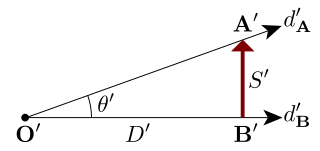  
|
In human visual perception, the visual angle, denoted θ, subtended by a viewed object sometimes looks larger or smaller than its actual value. One approach to this phenomenon posits a subjective correlate to the visual angle: the perceived visual angle or perceived angular size. An optical illusion where the physical and subjective angles differ is then called a visual angle illusion or angular size illusion.
The examples show the definitions of physical variables (in first diagram) and perceived variables (in second diagram) accompanying the visual angle subtended by an object arising from, and perpendicular to, the line of sight. Angular size illusions are most obvious as relative angular size illusions, in which two objects that subtend the same visual angle appear to have different angular sizes; it is as if their equal-sized images on the retina were of different sizes. Angular size illusions are contrasted with linear size illusions, in which two objects that are the same physical size do not appear so. An angular size illusion may be accompanied by (or cause) a linear size illusion at the same time. The following is a partial list of “size and distance” illusions that begin as visual angle illusions (angular size illusions) for most observers.
|
Peripheral Drift Illusion 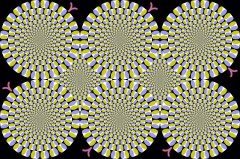 |
The peripheral drift illusion (PDI) refers to a motion illusion generated by the presentation of a sawtooth luminance grating in the visual periphery. This illusion was first described by Faubert and Herbert (1999), although a similar effect called the “escalator illusion” was reported by Fraser and Wilcox (1979). A variant of the PDI was created by Kitaoka Akiyoshi and Ashida (2003) who took the continuous sawtooth luminance change, and reversed the intermediate greys. Kitaoka has created numerous variants of the PDI, and one called “rotating snakes” has become very popular. The latter demonstration has kindled great interest in the PDI.
The illusion is easily seen when fixating off to the side of it, and then blinking as fast as possible. Most observers can see the illusion easily when reading text with the illusion figure in the periphery. The motion of such illusions is consistently perceived in a dark-to-light direction. Two papers have been published examining the neural mechanisms involved in seeing the PDI (Backus & Oruç, 2005; Conway et al., 2005). Faubert and Herbert (1999) suggested the illusion was based on temporal differences in luminance processing producing a signal that tricks the motion system. Both of the articles from 2005 are broadly consistent with those ideas, although contrast appears to be an important factor (Backus & Oruç, 2005). |
Phantogram |
Created using drawn images, photographs or computer-generated images, phantograms (also known as phantaglyphs, Op-Ups, free-standing anaglyphs, levitated images, and book anaglyphs) are a form of optical illusion deploying perspectival anamorphosis to produce a 2D image that is distorted in a particular way so as to appear, to a viewer at a particular vantage point, three-dimensional, standing above or recessed into a flat surface. The illusion of depth and perspective is heightened by stereoscopy techniques; a combination of two images, most typically but not necessarily an anaglyph (color filtered stereo image). Wearing common (red–cyan) 3D glasses, the viewer’s vision is segregated so that each eye sees a different image.
Phantograms work by presenting the viewer with a pair of flat images precisely distorted to mimic the anticipated perspective of a three-dimensional object viewed from the phantogram’s intended vantage point. As with other forms of stereoscopy, the illusion reproduces many of the visual cues associated with binocular depth perception, fooling the viewer’s vision into perceiving the two-dimensional images as having actual depth. The illusion is limited, however; phantograms lack some cues for depth perception such as convincing parallax, so the viewer must be stationary at the illusion’s “sweet spot”, a specific point at which the phantogram is designed to be most convincing. |
Phénakistiscope |
The phénakisticope was the first widespread animation device that created a fluid illusion of motion. The phénakistiscope is regarded as one of the first forms of moving media entertainment that paved the way for the future motion picture and film industry. It comes in the form of a spinning cardboard disc attached vertically to a handle. Arrayed radially around the disc’s centre are a series of pictures showing sequential phases of the animation. |
Phi Phenomenon |
The phi phenomenon is the optical illusion of perceiving a series of still images, when viewed in rapid succession, as continuous motion. Max Wertheimer, one of the three founders of Gestalt psychology, defined this phenomenon in 1912. The phi phenomenon and persistence of vision together formed the foundation of Hugo Münsterberg‘s theory of film and are part of the process of motion perception.
The phi phenomenon is similar to beta movement in that both cause sensation of movement. However, the phi phenomenon is an apparent movement caused by luminous impulses in sequence, whereas beta movement is an apparent movement caused by luminous stationary impulses. Persistence of vision, which is popularly taught as the reason for motion illusion, is in reality merely the reason that the black spaces that come between each “real” movie frame are not perceived, which makes the phi phenomenon the true reason for motion illusion in cinema and animation, including the phenakistoscope, zoetrope, and others. |
Poggendorff Illusion |
The Poggendorff illusion (1860) is a geometrical-optical illusion that involves the misperception of the position of one segment of a transverse line that has been interrupted by the contour of an intervening structure (here a rectangle). It is named after Johann Christian Poggendorff, the editor of the journal, who in 1860 discovered it in the figures Johann Karl Friedrich Zöllner submitted when first reporting on what is now known as the Zöllner illusion. The magnitude of the illusion depends on the properties of the obscuring pattern and the nature of its borders.
Many detailed studies of the illusion, including “amputating” various components point to its principal cause: acute angles in the figure are seen by viewers as expanded though the illusion diminishes or disappears when the transverse line is horizontal or vertical. Other factors are involved. |
Ponzo Illusion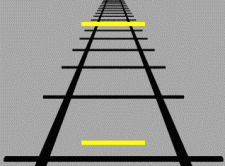 |
A geometrical-optical illusion (1911): two identical lines across a pair of converging lines, similar to railway tracks, are drawn. The upper line looks longer because we interpret the converging sides according to linear perspective as parallel lines receding into the distance. In this context, we interpret the upper line as though it were farther away, so we see it as longer – a farther object would have to be longer than a nearer one for both to produce retinal images of the same size. |
Rubin Vase |
A famous set of ambiguous or bi-stable (i.e., reversing) two-dimensional forms developed around 1915. This is an instance of multistability (or multistable perception), the tendency of ambiguous perceptual experiences to pop back and forth unstably between two or more alternative interpretations. |
Sander Illusion |
In Sander illusion or Sander’s parallelogram (1926), the diagonal line bisecting the larger, left-hand parallelogram appears to be considerably longer than the diagonal line bisecting the smaller, right-hand parallelogram, but is in fact the same length.
One possible reason for this illusion is that the diagonal lines around the blue lines give a perception of depth, and when the blue lines are included in that depth, they are perceived as different lengths. |
Silencing |
Silencing is an illusion in which a set of objects that change in luminance, hue, size, or shape appears to stop changing when it moves. It was discovered by Jordan Suchow and George Alvarez of Harvard University, and described in a paper published in Current Biology. Silencing won the Neural Correlate Society’s “Best visual illusion of the year contest” in 2011. |
| Size-Weight Illusion |
The size-weight illusion, also known as the Charpentier illusion or Charpentier–Koseleff illusion, occurs when a person underestimates the weight of a larger object (e.g. a box) when compared to a smaller object of the same mass. Similar illusions occurs with differences in material and colour: metal containers feel lighter than wooden containers of the same size and mass, and darker objects feel heavier than brighter objects of the same size and mass. These illusions can all be described as contrast with the expected weight. |
Stroboscopic Effect |
A visual phenomenon caused by aliasing that occurs when continuous motion is represented by a series of short or instantaneous samples. It also accounts for the “wagon-wheel effect“, so-called because in video, spoked wheels on horse-drawn wagons sometimes appear to be turning backwards.
A strobe fountain, a stream of water droplets falling at regular intervals lit with a strobe light, is an example of the stroboscopic effect being applied to a cyclic motion that is not rotational. When viewed under normal light, this is a normal water fountain. When viewed under a strobe light with its frequency tuned to the rate at which the droplets fall, the droplets appear to be suspended in mid-air. Adjusting the strobe frequency can make the droplets seemingly move slowly up or down.
|
| Swept-Plane Display | Swept-plane display is a structure from motion technique with which one can create the optical illusion of a volume of light, due to the persistence of vision property of human visual perception.
The principle is to have a 2D lighted surface sweep in a circle, creating a volume. The image on the 2D surface changes as the surface rotates. The lighted surface needs to be translucent. |
Ternus Illusion 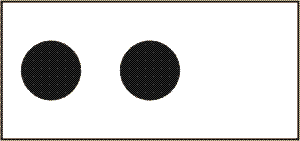 |
An illusion related to human visual perception involving apparent motion. Element motion is characterized as the outer disc in the Ternus display being seen as “jumping over” the other two discs in the display. Group motion gives the perceiver the illusion that all of the discs within the display are moving simultaneously to the right and then back again.
Though there are many ideas relating to causative factors, even current research seems to be lacking in a conclusive explanation for why the Ternus effect occurs and has not yet discovered exactly which mechanisms are responsible. Petersik and his team in 2006 suggested that intensive brain-imaging research on each percept is the way forward and is the most likely way to discover the answer. |
Thaumatrope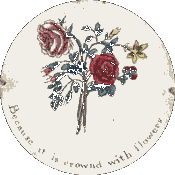 |
Popular in the 19th century, a thaumatrope is an optical toy — a disk with a picture on each side is attached to two pieces of string. When the strings are twirled quickly between the fingers the two pictures appear to blend into one due to the persistence of vision. Thaumatropes can provide an illusion of motion with the two sides of the disc each depicting a different phase of the motion, but no examples are known to have been produced until long after the introduction of the first widespread animation device: the phénakistiscope.
Thaumatropes are often seen as important antecedents of motion pictures and in particular of animation. This is partly due to many film historians’ belief that the associated theory of persistence of vision explains the physiological basis for movies, although this was disproved in 1912. |
Trompe-l’œil    |
Trompe-l’œil is an art technique that uses realistic imagery and perspectival illusionism to create the optical illusion that the depicted objects exist in three dimensions. It was (and is) often employed in murals. Instances from Greek and Roman times are known, for instance in Pompeii. A typical trompe-l’œil mural might depict a window, door or hallway, intended to suggest a larger room. Trompe-l’œil can also be found painted on tables and other items of furniture, on which, for example, a deck of playing cards might appear to be sitting on the table.
Riding on the widespread fascination with perspective drawing in the Renaissance, Italian painters of the late Quattrocento such as Andrea Mantegna (1431–1506) and Melozzo da Forlì (1438–1494), began painting illusionistic ceiling paintings, generally in fresco, that employed perspective and techniques such as foreshortening to create the impression of greater space for the viewer below. Forced perspective is a comparable illusion in architecture. Perspective theories in the 17th century allowed a more fully integrated approach to architectural illusion, which when used by painters to “open up” the space of a wall or ceiling is known as quadratura. Trompe-l’œil, in the form of “forced perspective“, has long been used in stage-theater set design, so as to create the illusion of a much deeper space than the actual stage. A famous early example is the Teatro Olimpico in Vicenza, with Vincenzo Scamozzi‘s seven forced-perspective “streets” (1585), which appear to recede into the distance. Trompe-l’œil is employed in Donald O’Connor‘s famous “Running up the wall” scene in the film Singin’ in the Rain (1954). During the finale of his “Make ’em Laugh” number he first runs up a real wall. Then he runs towards what appears to be a hallway, but when he runs up this as well we realize that it is a large trompe-l’œil mural. More recently, Roy Andersson has made use of similar techniques in his feature films. |
Troxler’s Fading |
Troxler’s fading, Troxler fading or the Troxler effect is an optical illusion affecting visual perception. When one fixates on a particular point for even a short period of time, an unchanging stimulus away from the fixation point will fade away and disappear. Recent research suggests that at least some portion of the perceptual phenomena associated with Troxler’s fading occurs in the brain.
Troxler’s fading has been attributed to the adaptation of neurons vital for perceiving stimuli in the visual system. It is part of the general principle in sensory systems that unvarying stimuli soon disappear from our awareness. For example, if a small piece of paper is dropped on the inside of one’s forearm, it is felt for a short period of time. Soon, however, the sensation fades away. This is because the tactile neurons have adapted and start to ignore the unimportant stimulus. But if one jiggles one’s arm up and down, giving varying stimulation, one will continue to feel the paper. Troxler’s fading can occur without any extraordinary stabilization of the retinal image in peripheral vision because the neurons in the visual system beyond the rods and cones have large receptive fields. This means that the small, involuntary eye movements made when fixating on something fail to move the stimulus onto a new cell’s receptive field, in effect giving unvarying stimulation. Further experimentation this century by Hsieh and Tse showed that at least some portion of the perceptual fading occurred in the brain, not in the eyes. |
Vertical-Horizontal Illusion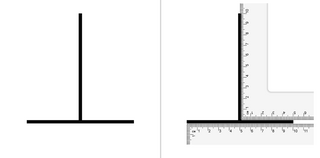 |
The Vertical-horizontal illusion is the tendency for observers to overestimate the length of a vertical line relative to a horizontal line of the same length. This even happens when people are aware that the lines are of the same length.
Cross-cultural differences in susceptibility to the vertical-horizontal illusion have been noted in several studies. People living in developed urban cities show greater susceptibility than people living in rural areas. An explanation could be that those in rural areas are more accustomed to living in round houses on flat plains, or scrubland. Rural inhabitants have more exposure to distance and living on plains than people living in highly developed, commercialized cultures. However, differences in the strength of the vertical-horizontal illusion or the related Müller-Lyer illusion for these groups are inconsistent at best. Gender differences have been found with regards to vertical-horizontal illusions. Rasmjou’s 1998 study found men to outperform women in perceiving the vertical–horizontal illusion. The results of this variation could be from hemispheric asymmetries, and/or biological differences between men’s and women’s brains. Functional applications of vertical-horizontal illusion exist. Elliot et al. studied the effects of the vertical–horizontal illusion and how the perceived illusion can influence visuo-motor coordination, i.e. motor activity dependent on sight. The study specifically focused on how the perceived height of a step, manipulated by the vertical–horizontal illusion, influenced stepping strategy as shown in toe elevation during step clearance. Their results showed an increased toe elevation in conditions where an illusion was perceived, leading them to conclude that there was a correlation between visual illusion and visuo-motor coordination. This can be implemented in the real world by developing better safety strategies in places such as nursing homes. |
Visual Tilt Effects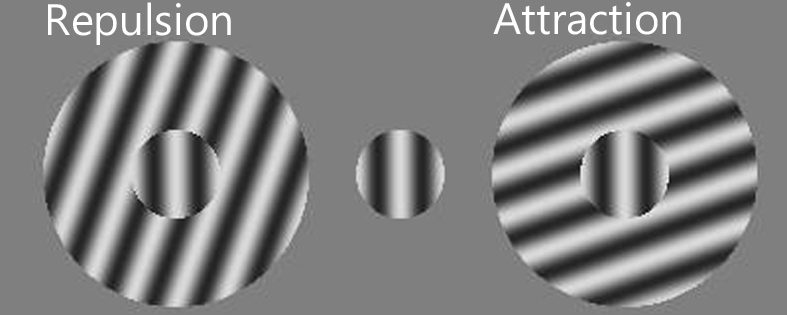 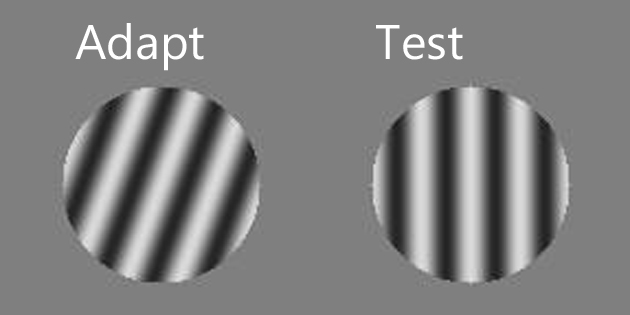 |
Due to the effect of a spatial context or temporal context, the perceived orientation of a test line or grating pattern can appear tilted away from its physical orientation. The tilt illusion (TI) is the phenomenon that the perceived orientation of a test line or grating is altered by the presence of surrounding lines or grating with a different orientation (spatial context). And the tilt aftereffect (TAE) is the phenomenon that the perceived orientation is changed after prolonged inspection of another oriented line or grating (temporal context). |
Wagon-Wheel Effect |
Also known as stagecoach-wheel effect or stroboscopic effect), the wagon-wheel effect is an optical illusion in which a spoked wheel appears to rotate differently from its true rotation. The wheel can appear to rotate more slowly than the true rotation, it can appear stationary, or it can appear to rotate in the opposite direction from the true rotation. This last form of the effect is sometimes called the reverse rotation effect.
This animated GIF demonstrates the wagon-wheel effect. The speed of the “camera”, moving towards the right, constantly increases at the same rate with the objects sliding to the left. Halfway through the 24-second loop, the objects appear to suddenly shift and head backwards. The wagon-wheel effect is most often seen in film or television depictions of stagecoaches or wagons in Western movies, although recordings of any regularly spoked rotating object will show it, such as helicopter rotors and aircraft propellers. In these recorded media, the effect is a result of temporal aliasing. It can also commonly be seen when a rotating wheel is illuminated by flickering light. These forms of the effect are known as stroboscopic effects: the original smooth rotation of the wheel is visible only intermittently. A version of the wagon-wheel effect can also be seen under continuous illumination. Imagine that the true rotation of a four-spoke wheel is clockwise. The first instance of visibility of the wheel may occur when one spoke is at 12 o’clock. If by the time the next instance of visibility occurs, the spoke previously at 9 o’clock has moved into the 12-o’clock position, then a viewer will perceive the wheel to be stationary. If at the second instance of visibility, the next spoke has moved to the 11:30 position, then a viewer will perceive the wheel to be rotating backwards. If at the second instance of visibility, the next spoke has moved to the 12:30 position, then a viewer will perceive the wheel to be rotating forwards, albeit more slowly than the wheel is actually rotating. The effect relies on a motion perception property called beta movement: motion is seen between two objects in different positions in the visual field at different times providing the objects are similar (which is true of spoked wheels—each spoke is essentially identical to the others) and providing the objects are close (which is true of the originally 9-o’clock spoke in the second instant—it is closer to 12 o’clock than the originally 12-o’clock spoke). The wagon-wheel effect is exploited in some engineering tasks, such as adjusting the timing of an engine. This same effect can make some rotating machines, such as lathes, dangerous to operate under artificial lighting because at certain speeds the machines will falsely appear to be stopped or to be moving slowly.
|
White’s Illusion |
White’s illusion is a brightness illusion where certain stripes of a black and white grating is partially replaced by a grey rectangle. Both of the grey bars of A and B are the same colour and opacity, even though rectangles A on the left look much darker than the rectangles B on the right. The brightness of the grey pieces appear to shift toward the brightness of the top and bottom bordering stripes. This is in apparent opposition to lateral inhibition as it cannot explain this occurrence. This occurs even when the grey patches in the black stripes are bordered by more white than black (and conversely for the grey patches in the white stripes). A similar illusion occurs when the horizontal strips have different colours; this is known as Munker-White’s illusion or Munker’s illusion.
|
Wundt Illusion |
The Wundt illusion is an optical illusion that was first described by the German psychologist Wilhelm Wundt in the 19th century. The two red vertical lines are both straight, but they may look as if they are bowed inwards to some observers. The distortion is induced by the crooked lines on the background. The Hering illusion produces a similar, but inverted effect. |
Zoetrope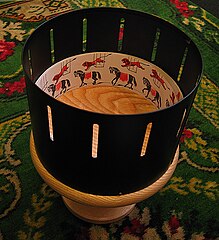  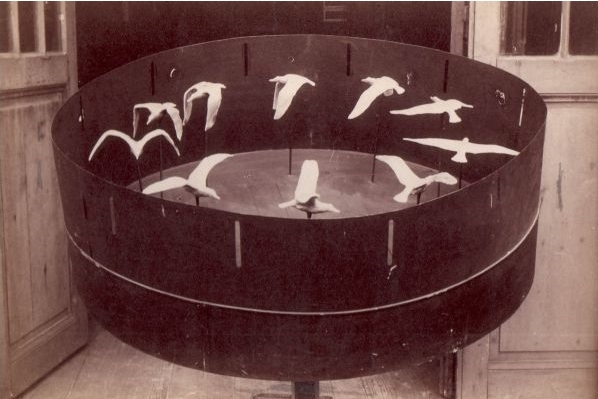 |
One of several pre-film animation devices that produce the illusion of motion by displaying a sequence of drawings or photographs showing progressive phases of that motion. The zoetrope comprises a cylinder with cuts vertically in the sides. On the inner surface of the cylinder is a band with images from a set of sequenced pictures. As the cylinder spins, the user looks through the slits at the pictures across. The scanning of the slits keeps the pictures from simply blurring together, and the user sees a rapid succession of images, producing the illusion of motion. From the late 19th century, devices working on similar principles have been developed, named analogously as linear zoetropes and 3D zoetropes, with traditional zoetropes referred to as “cylindrical zoetropes” if distinction is needed.
The zoetrope works on the same principle as its predecessor, the phénakisticope, but is more convenient and allows the animation to be viewed by several people at the same time. Instead of being radially arrayed on a disc, the sequence of pictures depicting phases of motion is on a paper strip. For viewing, this is placed against the inner surface of the lower part of an open-topped metal drum, the upper part of which is provided with a vertical viewing slit across from each picture. The drum, on a spindle base, is spun. The faster the drum is spun, the smoother the animation appears. |
Zöllner Illusion |
The Zöllner illusion is a classic optical illusion named after its discoverer, German astrophysicist Johann Karl Friedrich Zöllner. It creates the illusion that the series of parallel, black diagonal lines are not parallel. The shorter lines are on an angle to the longer lines, and this angle creates the impression that one end of the longer lines is nearer to the viewer than the other end.
This illusion is similar to the Hering illusion, the Poggendorff illusion and the Müller-Lyer illusion. All these illusions demonstrate how lines can seem to be distorted by their background. |
👁🗨 Animated Gifographic 👁
Optical Illusions: How Your Eyes Trick Your Mind

A stylized eye nearly identical to the one in the top portion of this gifographic is also presented by the BBC in a bespoke, interactive guide of the same title: How your eyes trick your mind
👁🗨 Infographic 👁
10 Rugs That Will Truly Mess With Your Friends’ Heads

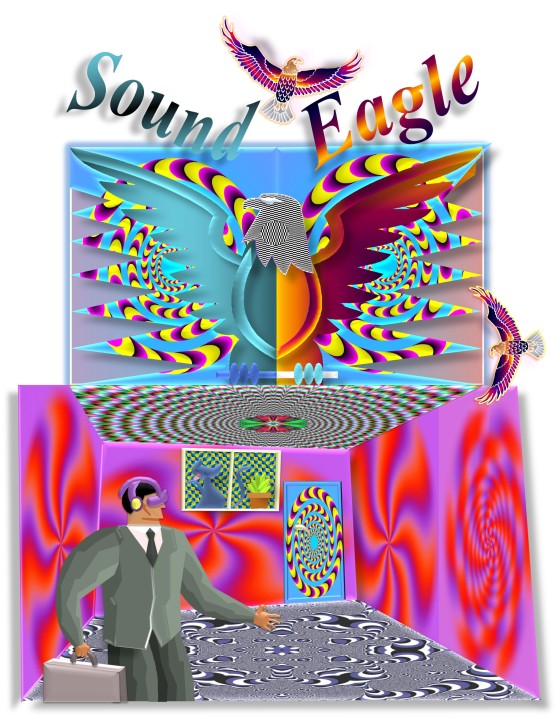

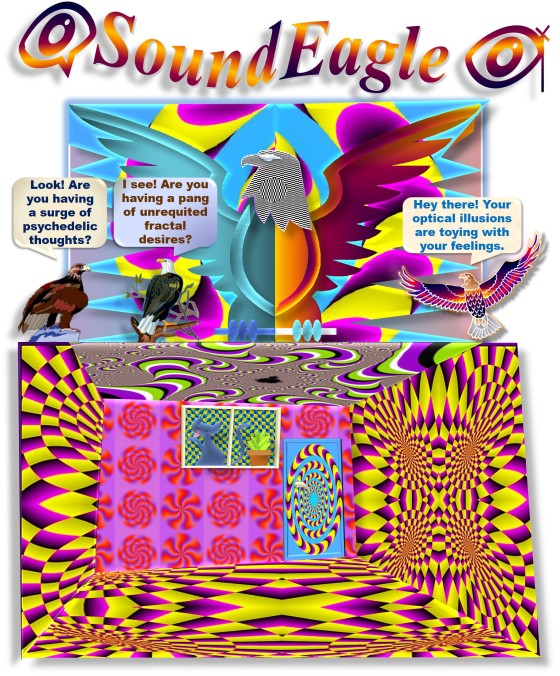

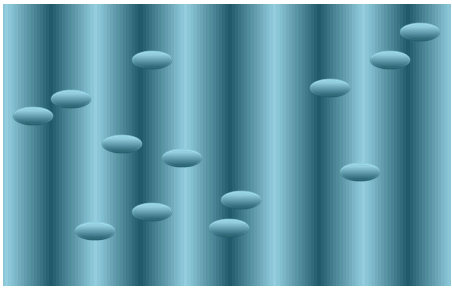








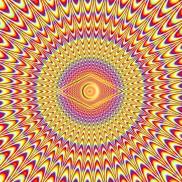















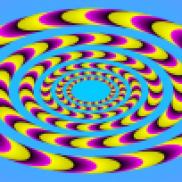
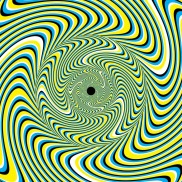
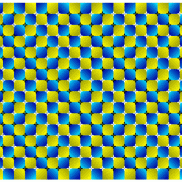







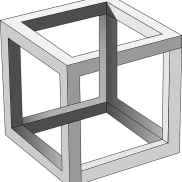






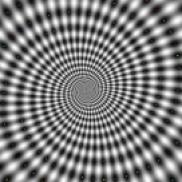








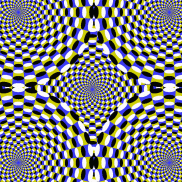


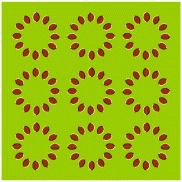








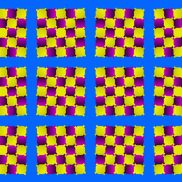




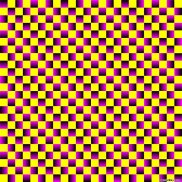





















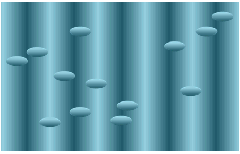


[…] On the one hand, we are continually carried along by many psychological processes, mental habits and internal states, which can influence our judgements and decisions by stealth. Given that people are responsive beings whose current emotions (such as joy, pleasure, empathy, trust, pride, confidence, surprise, hope, fear, anger, anxiety, contempt and other conscious experience) habitually influence their decisions, it would be quite difficult to avoid the affect heuristic, a rapid, involuntary emotional response, a kind of mental shortcut described in Wikipedia as “a subconscious process that shortens the decision-making process and allows people to function without having to complete an extensive search for information.” In other words, it is a simple, efficient rule that people often intuitively use to form judgements and make decisions such that “emotional response, or “affect” in psychological terms, plays a lead role.” Furthermore, people are at the mercy of attribute substitution, which happens when they have “to make a judgment (of a target attribute) that is computationally complex, and instead substitutes a more easily calculated heuristic attribute.” It is a psychological process that lies beneath a number of cognitive biases and perceptual illusions. […]
LikeLiked by 4 people
Man, you have so many websites and within each so many subjects it would take a lifetime. I settled on ‘Art’ and have enjoyed sampling many optical illusion videos. So mind blowing…Apologies though, I could never get through all of the text, although I may come back occasionally and taste a few lines here and there….
LikeLiked by 10 people
Hello John! SoundEagle is always delighted by your venturing into the multidisciplinary territories of this and other websites. Yes, this post can be quite a tour (de force) for some readers, though one would hope that you have found it to be as fascinating and informative as it is overwhelming and compelling, in both content and style.
If you should encounter other amazing or exciting optical art pieces, please feel free to inform us about where to look for them by dropping a line or two here.
LikeLiked by 5 people
That was a petty good post and compilation. Was a deep dive into optical illusion. Thank you for sharing all the information. 🙂
Enjoyed reading this one. Had seen quite a few of them on web. This one collected all the related ones together from various social media.
LikeLiked by 6 people
Thank you, Prakash, for finally taking the belated “deep dive into optical illusion” with SoundEagle, who has enjoyed your Conversation with Circle as much as you have enjoyed reading this post. It seems that we are quite adept at complementing each other with a form of symmetry. Without further ado, let’s present our creative interaction here for others to enjoy by quoting your Conversation with Circle followed by SoundEagle‘s response as follows:
Written for daily post prompt: Circle
Hi Prakash,
Here is SoundEagle’s continuation of your conversation with Circle:
In addition, Prakash, you are very welcome to observe another kind of collaborative symmetry at 🦅 SoundEagle in Art and Poetry 📜.
LikeLiked by 3 people
Granted that what we think we see is often not what we thought it was, Tweety Bird said “I tawt I taw a puddy tat” — and he actually did see a puddy tat. So we can always twust Tweety to tell the difference between optical illusions and reality.
LikeLiked by 5 people
Hello mistermuse! Speaking of seeing a pussycat, did you spot one in the banner positioned at the start of this post?
LikeLiked by 4 people
No, I didn’t spot it….but Tweety Bird probably did! 🙂
LikeLiked by 2 people
[…] Main Article: 👁 Optical Illusions 👁🗨❇️😵✳️👀 […]
LikeLiked by 4 people
Incredibly in depth! Am I seeing things?
LikeLiked by 5 people
A very intriguing and entertaining post, also many thanks for liking my comments on others sites!
LikeLiked by 5 people
I’m coming back to stare at each one – I may need an ambulance after
LikeLiked by 6 people
Hello Lara/Trace! SoundEagle is delighted that you found your way to this special post, the contents of which are simultaneously titillating and challenging to those who are visually acute, or those who are intimately in touch with their inner optical illusions.😵
Since you are endeavouring “to stare at each one”, have you worked out which ones are keeping you visually spellbound, optically entranced or perceptually confounded?
Please be informed that at the 👁🗨 Gallery 👁, you can click any image there to see the nearly 90 gallery images displayed in a full-size carousel view and to comment on each image, if you wish. Please enjoy!
LikeLiked by 3 people
Interesting and beautiful!
LikeLiked by 7 people
Again a lovely post on optical illusion. You have done a great job and u r very well informed too. Great words for all of us
LikeLiked by 6 people
Thank you for sharing such an amazing collection of optical illusion pictures and videos. 👌
LikeLiked by 5 people
Fun post. Quite interesting.
LikeLiked by 4 people
Thank you for this detailed article about optical organism functioning;
In the history, masters of magical phenomena were underlying it was especially optical illusion;
However, about recognizing that the brain has evolved to deal with natural stimuli in motion,
The brain doesn’t evolve deliberately to do anything;
It’s rather programmed for a limited margin of reactions;
And optical illusion is a prove that since events are not included in that margin, brain can’t assimilate them;
That’s a simple example that could be extrapolated for other biological functions.
In resume it’s like a computer; there is an integrated exploitation system the buyer have with the machine; then there are applications and programs the user could upload, manipulate, change, and modify and so on…
So human are born with an exploitation system, then they do what they can with depending on other external resources like education; environment and all factors around…
LikeLiked by 5 people
Dear 👁🗨 chems luc 👁
Hello! Thank you for your detailed comment submitted 17 months ago.
Given your interest in the topics of optical illusions, please be informed that SoundEagle🦅 has recently updated and improved the post even further. Due to its much extended length and scope, the post will take some time to load fully.
For the best result, please use a desktop or laptop computer with a large screen to view the rich multimedia contents available for heightening your multisensory enjoyment at SoundEagle🦅’s blogs and websites, some of which could be too powerful and feature-rich for iPad, iPhone, tablet or other portable devices to handle properly or adequately.
May you enjoy the full suite of optical illusions to your heart’s content!
ჱܓSoundEagle🦅
LikeLiked by 1 person
amazing, I especially love the frog and the horse !!
LikeLiked by 5 people
as someone who went to art school, this brought back fond memories. teachers were always trying to use optical illusions as a way to show color, light, and perspective.
but to me they’re just fun 😀
LikeLiked by 4 people
❄ ❄ ❆❅❆❅ ❆ ❄ ❄ Greetings from SoundEagle🦅 with chocolate-coated snowflakes for Mary Ramsey! Happy New Year to you! ✨🎉🎊🎄☃️🌟. Thank you for your visit and comment. SoundEagle🦅 is suitably impressed by your blogging and artistic talents, as amply demonstrated by your oeuvres exhibited at your WordPress and DeviantArt accounts. Your art definitely has a highly distinctive style as discernible as its subject matters, which include “unique superheroes; underrepresented minorities, LGBTQ, abuse victims, and so on.” Well done!
Given your penchant for, and devotion to, the visual arts, the following posts on SoundEagle🦅’s website could indeed entice and inspire you in their unique ways:
Please be informed that you might need to use a desktop or laptop computer with a large screen to view the rich multimedia contents available for heightening your multisensory enjoyment at my websites, some of which could be too powerful and feature-rich for iPad, iPhone, tablet or other portable devices to handle properly or adequately. A fast broadband connection is also helpful.
If your web browser can run Adobe Flash Player properly, then you will be able to play games, solve puzzles and/or see more animations on SoundEagle🦅’s website. Please enjoy the selected posts to your heart’s content!
Yours sincerely,
 ჱܓSoundEagle🦅
ჱܓSoundEagle🦅
LikeLiked by 1 person
Very interesting how the mind works!
LikeLiked by 4 people
Amazing !!
LikeLiked by 3 people
So interesting!
LikeLiked by 2 people
crazy pics👌👌
LikeLiked by 2 people
I wish I had time to read this college level dissertation. Skimmed through it and enjoyed several unfamiliar illusions. I will try to reserve more time in the future when I can take a break from my orojects. Thanks for your efforts. I hope you don’t think this is too “terse”. Be well. J
LikeLiked by 2 people
great work
LikeLiked by 2 people
Wow! I take my hat off to you my friend! Lots of information here and I learnt so much. Thanks for sharing.
LikeLiked by 2 people
Optical illusions are a fascination of mine. Enjoyed the coffee bean cartoon. Best Wishes.
LikeLiked by 2 people
Dear 👁🗨 Michael 👁
This post covers the topics of optical illusions quite comprehensively. Given its length and scope, it will take some time to load fully.
You are hereby cordially invited to revisit the post, as SoundEagle🦅 has recently updated and improved the post even further.
It is advisable to rely on a desktop or laptop computer with a large screen to view the rich multimedia contents available for heightening your multisensory enjoyment at SoundEagle🦅’s blogs and websites, some of which could be too powerful and feature-rich for iPad, iPhone, tablet or other portable devices to handle properly or adequately. Happy Sunday to you!
ჱܓSoundEagle🦅
LikeLiked by 2 people
Thank You, SoundEagle. Your posts challenge even my laptop.
LikeLiked by 2 people
Dear 👁🗨 Michael 👁
You are very welcome! This post should fully load in less than 10 seconds on a decent computer with a reasonably fast broadband connection.
The longer posts published on SoundEagle🦅’s blog may function as benchmarks or test pages to assess the speed and capability of a computer by timing how long the computer takes to load those lengthy multimedia posts, and also gauge how well it can display the advanced features of the posts. Listed below in chronological order are ten of the longest posts recommended for putting your computer to its pace.
By the way, your photography is deliciously exquisite and the subject matters that you have chosen are also appealing. Keep up the good work!
ჱܓSoundEagle🦅
LikeLiked by 1 person
Waw..such a colourful blog and interesting too..lovely 😊👍🏻..
LikeLiked by 2 people
Do, people are emotional receptacles that transmit delusions and illusions.🤔
LikeLiked by 2 people
Perhaps because human beings are so dependent on their vision, optical illusions are endlessly fascinating. I especially enjoyed the explanation of the “moon illusion”.
LikeLiked by 2 people
I love this one so much 😍 this is an awesome job really. My friend how long does it take you to do this? Much respect!
LikeLiked by 2 people
Fascinating post about a fascinating subject! I’m always mesmerised by optical illusions.
Many thanks for stopping by my travel and photography blog – much appreciated.
LikeLiked by 2 people
I am so happy to read this. This is the kind of manual that needs to be given and not the random misinformation that is at the other blogs. Appreciate your sharing this greatest doc.
LikeLiked by 2 people
This was amazing! My mind is blown!
LikeLiked by 1 person
Most folks will agree with your post even though its missing a few examples.
LikeLiked by 1 person
Dear SoundEagle 🦅,
Wow! SoundEagle 🦅, it’s bombastic! Fantastic optical illusions. I felt like I was hypnotized. I visit this post many times, many days. A wealth of wonderful and endless illusions and interesting information.It is true that I still have a lot to see in this post as it does not seem to end, but I’m so impressed. I admire your work on this bloog entry. You’re great and perfect, SoundEagle. Respect!
Best wishes!
Yours sincerely,
Polski Ryś
LikeLiked by 1 person
Dear 👁🗨 Polski Ryś 👁
Your visiting and com(pli)menting on this hypnotizing post filled with mesmerizing contents about optical illusions are highly appreciated.
You are hereby cordially invited to revisit the post, to which SoundEagle🦅 has recently added more captivating videos.
Happy July to you soon!
ჱܓSoundEagle🦅
LikeLike
Dear SoundEagle 🦅,
Here is a post dedicated to my wife. A wonderful and so kind woman. She is the best. As my dearest friend, I invite you to read this post and get to know my wife through it.
Yours sincerely,
Polski Ryś
Link to the post:
https://polskirys.art.blog/2021/05/25/blask-w-twoich-oczach-zawsze-oniesmielal-mnie-the-glow-in-your-eyes-has-always-intimidated-me/
LikeLiked by 1 person
You have gathered a ton of fine examples here… many of which I had never seen before!
LikeLiked by 1 person
[…] 2017 […]
LikeLike
Oh my goodness… So, so much information here it took an age just to load.. Amazing visuals collection and subject matter SE… A remarkable post..
Have a great rest of your week 🙂
LikeLiked by 1 person
[…] 👁 Optical Illusions 👁🗨❇️😵✳️👀 […]
LikeLike